

Concept Papers in Research: Deciphering the blueprint of brilliance
Concept papers hold significant importance as a precursor to a full-fledged research proposal in academia and research. Understanding the nuances and significance of a concept paper is essential for any researcher aiming to lay a strong foundation for their investigation.
Table of Contents
What Is Concept Paper
A concept paper can be defined as a concise document which outlines the fundamental aspects of a grant proposal. It outlines the initial ideas, objectives, and theoretical framework of a proposed research project. It is usually two to three-page long overview of the proposal. However, they differ from both research proposal and original research paper in lacking a detailed plan and methodology for a specific study as in research proposal provides and exclusion of the findings and analysis of a completed research project as in an original research paper. A concept paper primarily focuses on introducing the basic idea, intended research question, and the framework that will guide the research.
Purpose of a Concept Paper
A concept paper serves as an initial document, commonly required by private organizations before a formal proposal submission. It offers a preliminary overview of a project or research’s purpose, method, and implementation. It acts as a roadmap, providing clarity and coherence in research direction. Additionally, it also acts as a tool for receiving informal input. The paper is used for internal decision-making, seeking approval from the board, and securing commitment from partners. It promotes cohesive communication and serves as a professional and respectful tool in collaboration.
These papers aid in focusing on the core objectives, theoretical underpinnings, and potential methodology of the research, enabling researchers to gain initial feedback and refine their ideas before delving into detailed research.
Key Elements of a Concept Paper
Key elements of a concept paper include the title page , background , literature review , problem statement , methodology, timeline, and references. It’s crucial for researchers seeking grants as it helps evaluators assess the relevance and feasibility of the proposed research.
Writing an effective concept paper in academic research involves understanding and incorporating essential elements:
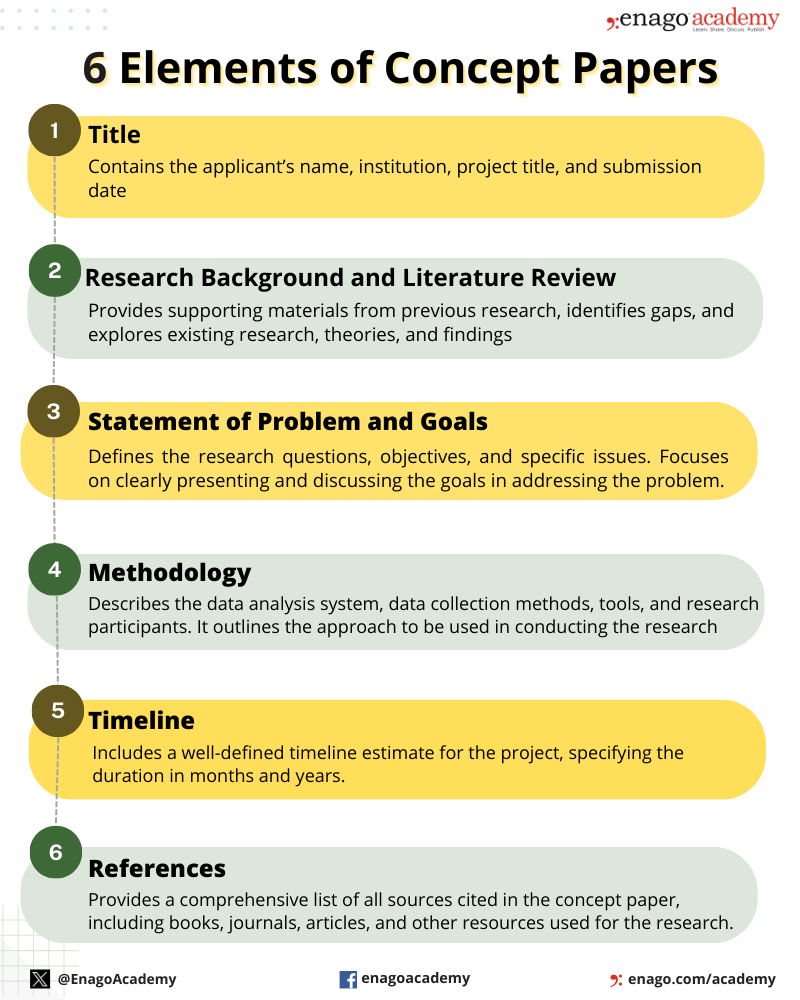
How to Write a Concept Paper?
To ensure an effective concept paper, it’s recommended to select a compelling research topic, pose numerous research questions and incorporate data and numbers to support the project’s rationale. The document must be concise (around five pages) after tailoring the content and following the formatting requirements. Additionally, infographics and scientific illustrations can enhance the document’s impact and engagement with the audience. The steps to write a concept paper are as follows:
1. Write a Crisp Title:
Choose a clear, descriptive title that encapsulates the main idea. The title should express the paper’s content. It should serve as a preview for the reader.
2. Provide a Background Information:
Give a background information about the issue or topic. Define the key terminologies or concepts. Review existing literature to identify the gaps your concept paper aims to fill.
3. Outline Contents in the Introduction:
Introduce the concept paper with a brief overview of the problem or idea you’re addressing. Explain its significance. Identify the specific knowledge gaps your research aims to address and mention any contradictory theories related to your research question.
4. Define a Mission Statement:
The mission statement follows a clear problem statement that defines the problem or concept that need to be addressed. Write a concise mission statement that engages your research purpose and explains why gaining the reader’s approval will benefit your field.
5. Explain the Research Aim and Objectives:
Explain why your research is important and the specific questions you aim to answer through your research. State the specific goals and objectives your concept intends to achieve. Provide a detailed explanation of your concept. What is it, how does it work, and what makes it unique?
6. Detail the Methodology:
Discuss the research methods you plan to use, such as surveys, experiments, case studies, interviews, and observations. Mention any ethical concerns related to your research.
7. Outline Proposed Methods and Potential Impact:
Provide detailed information on how you will conduct your research, including any specialized equipment or collaborations. Discuss the expected results or impacts of implementing the concept. Highlight the potential benefits, whether social, economic, or otherwise.
8. Mention the Feasibility
Discuss the resources necessary for the concept’s execution. Mention the expected duration of the research and specific milestones. Outline a proposed timeline for implementing the concept.
9. Include a Support Section:
Include a section that breaks down the project’s budget, explaining the overall cost and individual expenses to demonstrate how the allocated funds will be used.
10. Provide a Conclusion:
Summarize the key points and restate the importance of the concept. If necessary, include a call to action or next steps.
Although the structure and elements of a concept paper may vary depending on the specific requirements, you can tailor your document based on the guidelines or instructions you’ve been given.
Here are some tips to write a concept paper:
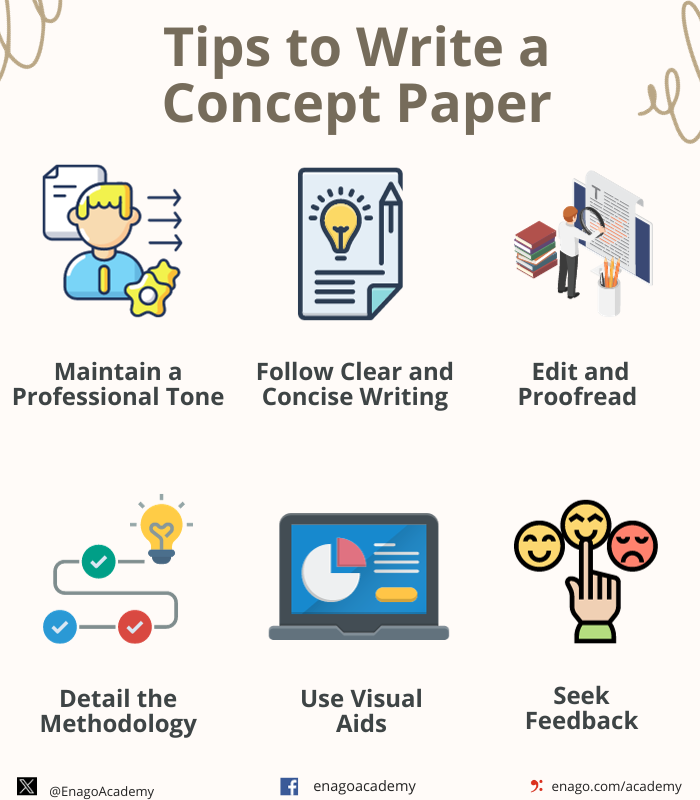
Example of a Concept Paper
Here is an example of a concept paper. Please note, this is a generalized example. Your concept paper should align with the specific requirements, guidelines, and objectives you aim to achieve in your proposal. Tailor it accordingly to the needs and context of the initiative you are proposing.
Download Now!
Importance of a Concept Paper
Concept papers serve various fields, influencing the direction and potential of research in science, social sciences, technology, and more. They contribute to the formulation of groundbreaking studies and novel ideas that can impact societal, economic, and academic spheres.
A concept paper serves several crucial purposes in various fields:
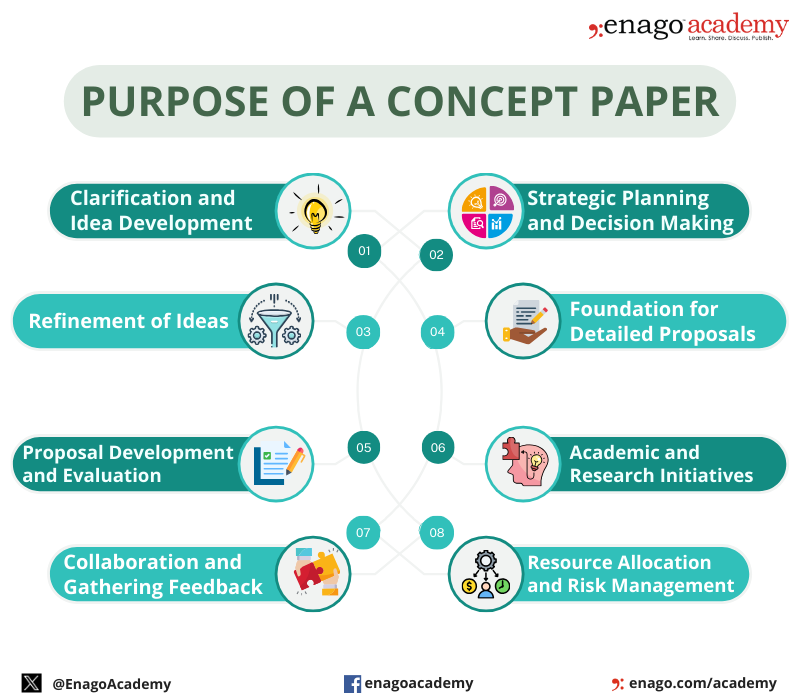
In summary, a well-crafted concept paper is essential in outlining a clear, concise, and structured framework for new ideas or proposals. It helps in assessing the feasibility, viability, and potential impact of the concept before investing significant resources into its implementation.
How well do you understand concept papers? Test your understanding now!
Fill the Details to Check Your Score

Role of AI in Writing Concept Papers
The increasing use of AI, particularly generative models, has facilitated the writing process for concept papers. Responsible use involves leveraging AI to assist in ideation, organization, and language refinement while ensuring that the originality and ethical standards of research are maintained.
AI plays a significant role in aiding the creation and development of concept papers in several ways:
1. Idea Generation and Organization
AI tools can assist in brainstorming initial ideas for concept papers based on key concepts. They can help in organizing information, creating outlines, and structuring the content effectively.
2. Summarizing Research and Data Analysis
AI-powered tools can assist in conducting comprehensive literature reviews, helping writers to gather and synthesize relevant information. AI algorithms can process and analyze vast amounts of data, providing insights and statistics to support the concept presented in the paper.
3. Language and Style Enhancement
AI grammar checker tools can help writers by offering grammar, style, and tone suggestions, ensuring professionalism. It can also facilitate translation, in case a global collaboration.
4. Collaboration and Feedback
AI platforms offer collaborative features that enable multiple authors to work simultaneously on a concept paper, allowing for real-time contributions and edits.
5. Customization and Personalization
AI algorithms can provide personalized recommendations based on the specific requirements or context of the concept paper. They can assist in tailoring the concept paper according to the target audience or specific guidelines.
6. Automation and Efficiency
AI can automate certain tasks, such as citation formatting, bibliography creation, or reference checking, saving time for the writer.
7. Analytics and Prediction
AI models can predict potential outcomes or impacts based on the information provided, helping writers anticipate the possible consequences of the proposed concept.
8. Real-Time Assistance
AI-driven chat-bots can provide real-time support and answers to specific questions related to the concept paper writing process.
AI’s role in writing concept papers significantly streamlines the writing process, enhances the quality of the content, and provides valuable assistance in various stages of development, contributing to the overall effectiveness of the final document.
Concept papers serve as the stepping stone in the research journey, aiding in the crystallization of ideas and the formulation of robust research proposals. It the cornerstone for translating ideas into impactful realities. Their significance spans diverse domains, from academia to business, enabling stakeholders to evaluate, invest, and realize the potential of groundbreaking concepts.
Frequently Asked Questions
A concept paper can be defined as a concise document outlining the fundamental aspects of a grant proposal such as the initial ideas, objectives, and theoretical framework of a proposed research project.
A good concept paper should offer a clear and comprehensive overview of the proposed research. It should demonstrate a strong understanding of the subject matter and outline a structured plan for its execution.
Concept paper is important to develop and clarify ideas, develop and evaluate proposal, inviting collaboration and collecting feedback, presenting proposals for academic and research initiatives and allocating resources.
I got wonderful idea
Rate this article Cancel Reply
Your email address will not be published.

Enago Academy's Most Popular Articles

- AI in Academia
- Trending Now
Simplifying the Literature Review Journey — A comparative analysis of 6 AI summarization tools
Imagine having to skim through and read mountains of research papers and books, only to…

- Reporting Research
How to Improve Lab Report Writing: Best practices to follow with and without AI-assistance
Imagine you’re a scientist who just made a ground-breaking discovery! You want to share your…

Achieving Research Excellence: Checklist for good research practices
Academia is built on the foundation of trustworthy and high-quality research, supported by the pillars…

- Industry News
COPE Forum Discussion Highlights Challenges and Urges Clarity in Institutional Authorship Standards
The COPE forum discussion held in December 2023 initiated with a fundamental question — is…

Research Recommendations – Guiding policy-makers for evidence-based decision making
Research recommendations play a crucial role in guiding scholars and researchers toward fruitful avenues of…

Sign-up to read more
Subscribe for free to get unrestricted access to all our resources on research writing and academic publishing including:
- 2000+ blog articles
- 50+ Webinars
- 10+ Expert podcasts
- 50+ Infographics
- 10+ Checklists
- Research Guides
We hate spam too. We promise to protect your privacy and never spam you.
I am looking for Editing/ Proofreading services for my manuscript Tentative date of next journal submission:

What should universities' stance be on AI tools in research and academic writing?
How to Write a Concept Paper Easily with Our Guide

Did you know that some of the most revolutionary ideas in history started with a simple concept paper? From scientific breakthroughs to groundbreaking inventions, the power of well-crafted concept papers cannot be underestimated.
In this article, experts at our academic essay writing service will demystify the process of writing a concept paper, offering straightforward tips and guidance to help you articulate your ideas effectively. Whether you're a researcher, entrepreneur, or student, you'll lay the foundation for your next big endeavor effortlessly.
Defining What is a Concept Paper
A concept paper is a starting point for any major project or research endeavor. When you're asked to write one, what your teachers or professors are really asking for is a clear, concise summary of what you plan to explore or investigate. It's your chance to explain your idea, why it matters, and how you're going to tackle it.
Imagine you're pitching your idea to someone who doesn't know anything about it. You want to grab their attention and get them excited about what you're planning to do. That's what a concept paper is all about – setting the stage for your project or research in a way that makes people want to learn more.
Don't Delay Your Scholarly Pursuits!
Our team is here to nurture your concepts! Seize this opportunity to lay the groundwork for your academic exploration.
Why Does a Concept Paper Matter
So, why does knowing how to write a concept paper for academic research matter? First off, it helps you clarify your thoughts and organize your ideas. Writing down your concept forces you to think through the details of your project, which can be super helpful, especially when things start to get overwhelming.
Secondly, it's a way to get feedback early on. By sharing your concept paper with your teachers, advisors, or classmates, you can get valuable input that can help you refine your idea and make it even better.
Plus, it shows that you're serious about your project. Taking the time to write a concept paper demonstrates to your instructors that you've put thought and effort into your work, which can earn you some serious brownie points.
Understanding How Long is a Concept Paper
When it comes to the length of a concept paper, think quality over quantity. It's not about hitting a specific word count; it's about conveying your ideas clearly and concisely. In general, a concept paper is meant to be short and to the point. You want to give enough detail to explain your idea thoroughly, but you don't want to overwhelm your reader with unnecessary information.
As a rule of thumb, most concept papers range from 1 to 3 pages. However, this can vary depending on your specific assignment or the requirements of the project you're proposing.
The key is to focus on the essentials. Include a brief introduction to your topic, a clear statement of your purpose or objective, an overview of your methodology or approach, and a summary of the potential impact or significance of your project. And if you ever need further help, simply ask us - write my research paper for the professionally crafted project.
Concept Paper Vs. Research Paper
While both concept papers and research papers are common in academia, they serve different purposes and have distinct formats.
.webp)
A concept paper, as we've discussed, is a concise document that outlines the basic idea or proposal for a project. It's like the blueprint or roadmap for your research endeavor. The focus here is on articulating the central concept, defining the objectives, and outlining the methodology. Think of writing a concept paper as laying the groundwork before diving into the detailed work of a research project.
On the other hand, a research paper is a more comprehensive and in-depth exploration of a topic or question. It involves conducting original research, analyzing data, and presenting findings in a formal written format. Research papers typically follow a structured format, including an introduction, literature review, methodology, results, discussion, and conclusion.
How to Write a Concept Paper in 8 Steps
Alright, getting into the nitty-gritty of writing your concept paper format might seem a bit overwhelming at first, but don't worry! We've got your back. By breaking down the process into eight manageable steps, we'll guide you through each stage with clarity and confidence.
.webp)
Define the Study Title and Its Objectives
The first crucial step in crafting your concept paper is to clearly define the study title and its objectives. This sets the foundation for your entire paper and helps guide your research direction.
Begin by crafting a clear and concise title that effectively communicates the essence of your study. Your title should be descriptive yet succinct, giving readers a glimpse into the focus of your research.
Next, outline the objectives of your study. What specific goals do you aim to achieve through your research? Be precise and realistic in outlining these objectives, ensuring they are achievable within the scope of your study.
Explain the Study's Context and Extent
After defining the title and objectives, it's essential to provide context and define the extent of your study. This step of how to write a concept paper for college helps readers understand the background and scope of your research.
Start by providing background information on the topic of your study. Discuss relevant theories, concepts, or existing research that contextualizes your work and highlights its importance.
Next, define the extent of your study by outlining its boundaries and limitations. What specific aspects of the topic will you focus on, and what areas will you exclude? Clarifying these boundaries helps ensure that your research remains focused and manageable.
Additionally, consider discussing the significance of your study within the broader field. How does your research contribute to existing knowledge, and what potential impact does it have?
Identify the Issue
This is where you clearly articulate the core challenge or question that your research seeks to explore. Start by providing a concise overview of the issue at hand. What is the specific problem or question that motivates your research? Why is it important or relevant within your field of study?
Next, consider providing context or background information that helps readers understand the significance of the issue. This could include discussing relevant trends, statistics, or real-world examples that highlight the importance of addressing the problem.
Finally, be sure to articulate the significance of the issue within the broader context of your field. Why is it important to study this particular issue, and what potential impact could your research have on addressing it?
List Goals and Objectives
In this step, you'll make a concept paper outline of the specific goals and objectives of your study. Goals represent the broader aims of your research, while objectives provide clear, measurable steps toward achieving those goals.
Start by defining your overarching goals. What do you hope to accomplish through your research? Think about the broader outcomes or changes you aim to bring about in your field or community.
Next, break down these goals into smaller, achievable objectives. Objectives should be specific, measurable, achievable, relevant, and time-bound (SMART). They should outline the concrete steps you will take to accomplish your goals.
Consider organizing your goals and objectives into a hierarchical structure, with broader goals at the top and more specific objectives underneath. Even if you'd rather buy essay from our pros, this step will help you provide clarity and coherence to your research plan.
Approach and Methodology
In this step, you'll detail the approach and methodology you'll use to conduct your research. According to our expert thesis writing service , this section is crucial as it outlines the methods you'll employ to address your research question and achieve your objectives.
Start by explaining your overall approach to research. Will you be conducting qualitative or quantitative research, or perhaps a combination of both? Describe the rationale behind your chosen approach and how it aligns with your research goals.
Next, outline the specific methodologies you'll use to collect and analyze data. This may include methods such as surveys, interviews, experiments, or literature reviews. Provide justification for why each method is appropriate for addressing your research question and objectives.
Be sure to consider any ethical considerations or limitations associated with your chosen methodologies and outline how you plan to address them.
Finally, discuss your data analysis plan. How will you analyze the data you collect to draw meaningful conclusions? Will you use statistical analysis, thematic coding, or another method?
Overview of Planned Methods and Expected Outcomes
In this step of how to write a concept paper for research, you'll provide an overview of the specific methods you plan to use and outline the expected outcomes or results.
Start by summarizing the methods you'll employ to collect data. This may include qualitative methods such as interviews or focus groups, quantitative methods such as surveys or experiments, or a combination of both. Briefly explain why you've chosen these methods and how they align with your research goals.
Next, outline the planned steps for implementing each method. Describe the procedures you'll follow to collect and analyze data, including any tools or instruments you'll use.
After detailing your methods, discuss the expected outcomes or results of your research. What do you hope to learn or discover through your study? How will your findings contribute to existing knowledge in your field?
Be realistic in your expectations and consider potential challenges or limitations that may affect your results. By acknowledging these factors upfront, you demonstrate a thoughtful and nuanced understanding of your research process.
Include Supporting Details
Here, you'll enrich your concept paper by incorporating supporting details that bolster your argument and provide additional context for your research.
Start by providing relevant background information or literature reviews that support your research topic. This could include citing key studies, theories, or concepts that inform your understanding of the issue.
Next, consider including any relevant data, statistics, or examples that illustrate the significance of your research topic. This could involve presenting findings from previous studies, real-world examples, or case studies that highlight the need for further investigation.
Additionally, discuss any theoretical frameworks or conceptual models that underpin your research approach. How do these frameworks help guide your study and shape your research questions?
Finally, be sure to cite your sources properly using the appropriate citation style (e.g., APA, MLA). This demonstrates academic integrity and allows readers to verify the information you've presented.
Wrap Up with a Summary
In this final step, you'll bring your concept paper to a close by summarizing the key points and reinforcing the significance of your research.
If you're uncertain how to write a conclusion for an essay , start by briefly recapping the main elements of your concept paper, including the research topic, objectives, methodology, and expected outcomes. This helps reinforce the central message of your paper and reminds readers of the key insights you've presented.
Next, reiterate the importance of your research topic and its potential impact within your field. Emphasize how your study fills a gap in existing knowledge or addresses a pressing issue, highlighting the relevance and significance of your research.
Finally, conclude with a call to action or a thought-provoking statement that encourages further reflection or discussion. This could involve suggesting avenues for future research, proposing practical implications for policymakers or practitioners, or inviting readers to consider the broader implications of your findings.
Tips for Writing a Concept Paper
Now that you've got a solid understanding of how to write a concept paper, let's explore some invaluable tips to help you navigate the writing process with finesse.
- Be Specific in Your Objectives : Clearly define your objectives with measurable outcomes. Avoid vague language and ensure each objective is actionable and achievable within the scope of your study. Specific objectives provide clarity and help guide your research effectively.
- Provide Contextual Background : Offer sufficient background information to contextualize your research topic. This includes explaining relevant theories, historical context, or existing literature related to your study. Providing context in your concept paper helps readers understand the significance of your research and its relevance within the broader field.
- Justify Your Methodological Choices : Explain why you've chosen specific research methods and justify their appropriateness for your study. Consider factors such as feasibility, ethical considerations, and alignment with your research objectives. Providing a rationale for your methodological choices adds credibility to your research approach.
- Anticipate and Address Limitations : Acknowledge potential limitations or challenges associated with your study and discuss how you plan to mitigate them. This demonstrates a thoughtful approach to your research and shows that you've considered the broader implications of your study. Being transparent about limitations also helps manage expectations and build trust with your audience.
Concept Paper Example
Now that we've explored the steps and tips for writing a concept paper let's put theory into practice. In this section, we'll provide you with a concept paper example to illustrate how these principles can be applied in a real-world scenario.
Eager to See Your Ideas Leap Off the Page?
Don't wait any longer—bring your concepts to life with our expertly crafted concept papers.
Concept Paper Topics
In this section, we'll provide you with a range of thought-provoking concept paper ideas spanning various disciplines and interests. Whether you're passionate about social issues, scientific advancements, or want to learn how to research a topic on cultural phenomena, you're sure to find inspiration here.
- The Influence of Instagram Fitness Influencers on Body Image Perception Among Adolescent Girls
- Implementing Bicycle-Sharing Programs to Reduce Carbon Emissions in Downtown Metropolitan Areas
- Analyzing the Effectiveness of Food Pantry Programs in Alleviating Food Insecurity Among Undergraduate Students at Urban Universities
- Assessing the Accuracy and Efficiency of Machine Learning Algorithms in Early Detection of Breast Cancer Using Medical Imaging Data
- Strategies for Increasing Female Representation in Computer Science and Engineering Programs at Universities
- Investigating the Impact of Workplace Mindfulness Programs on Employee Burnout Rates in High-stress Industries
- Barriers to Accessing Mental Health Services in Rural Appalachia: A Case Study
- The Ecological Impact of Microplastic Contamination on Coral Reef Ecosystems in the Caribbean
- Addressing Online Harassment and Cyberbullying Among Middle School Students Through Digital Literacy Education Programs
- The Relationship Between Proximity to Parks and Greenspaces and Mental Health Outcomes in Urban Dwellers: A Cross-sectional Study
- Virtual Reality Rehabilitation for Upper Limb Motor Recovery After Stroke: A Comparative Analysis of Traditional Therapy Methods
- Evaluating the Economic Viability and Environmental Sustainability of Indoor Vertical Farming Systems in Urban Settings
- Psychological Profiles of Adolescent Online Gamers: A Longitudinal Study on Risk Factors for Gaming Addiction
- Peer Mentoring Interventions for Improving Academic Performance and Retention Rates Among First-generation College Students in STEM Majors
- Universal Basic Income Pilot Programs: Assessing Socioeconomic Impacts and Policy Implications in Scandinavian Countries.
And there you have it - you've journeyed through the ins and outs of concept paper writing! You've learned the ropes, discovered valuable tips, explored an example, and got a bunch of topic ideas to fuel your creativity.
Now armed with the know-how, it's time to dive in and start crafting your concept paper. Remember to keep it focused, stay organized, and don't forget to let your passion shine through. With your enthusiasm and newfound skills, there's no doubt you'll create a paper that grabs attention and makes a real impact in your field.
Related Articles
.webp)

Community Blog
Keep up-to-date on postgraduate related issues with our quick reads written by students, postdocs, professors and industry leaders.
What is a Concept Paper and How do You Write One?
- By DiscoverPhDs
- August 26, 2020

What is a Concept Paper?
A concept paper is a short document written by a researcher before starting their research project, with the purpose of explaining what the study is about, why it is important and the methods that will be used.
The concept paper will include your proposed research title, a brief introduction to the subject, the aim of the study, the research questions you intend to answer, the type of data you will collect and how you will collect it. A concept paper can also be referred to as a research proposal.
What is the Purpose of a Concept Paper?
The primary aim of a research concept paper is to convince the reader that the proposed research project is worth doing. This means that the reader should first agree that the research study is novel and interesting. They should be convinced that there is a need for this research and that the research aims and questions are appropriate.
Finally, they should be satisfied that the methods for data collection proposed are feasible, are likely to work and can be performed within the specific time period allocated for this project.
The three main scenarios in which you may need to write a concept paper are if you are:
- A final year undergraduate or master’s student preparing to start a research project with a supervisor.
- A student submitting a research proposal to pursue a PhD project under the supervision of a professor.
- A principal investigator submitting a proposal to a funding body to secure financial support for a research project.
How Long is a Concept Paper?
The concept paper format is usually between 2 and 3 pages in length for students writing proposals for undergraduate, master’s or PhD projects. Concept papers written as part of funding applications may be over 20 pages in length.
How do you Write a Concept Paper?
There are 6 important aspects to consider when writing a concept paper or research proposal:
- 1. The wording of the title page, which is best presented as a question for this type of document. At this study concept stage, you can write the title a bit catchier, for example “Are 3D Printed Engine Parts Safe for Use in Aircraft?”.
- A brief introduction and review of relevant existing literature published within the subject area and identification of where the gaps in knowledge are. This last bit is particularly important as it guides you in defining the statement of the problem. The concept paper should provide a succinct summary of ‘the problem’, which is usually related to what is unknown or poorly understood about your research topic . By the end of the concept paper, the reader should be clear on how your research idea will provide a ‘solution’ to this problem.
- The overarching research aim of your proposed study and the objectives and/or questions you will address to achieve this aim. Align all of these with the problem statement; i.e. write each research question as a clear response to addressing the limitations and gaps identified from previous literature. Also give a clear description of your primary hypothesis.
- The specific data outputs that you plan to capture. For example, will this be qualitative or quantitative data? Do you plan to capture data at specific time points or at other defined intervals? Do you need to repeat data capture to asses any repeatability and reproducibility questions?
- The research methodology you will use to capture this data, including any specific measurement or analysis equipment and software you will use, and a consideration of statistical tests to help interpret the data. If your research requires the use of questionnaires, how will these be prepared and validated? In what sort of time frame would you plan to collect this data?
- Finally, include a statement of the significance of the study , explaining why your research is important and impactful. This can be in the form of a concluding paragraph that reiterate the statement of the problem, clarifies how your research will address this and explains who will benefit from your research and how.
You may need to include a short summary of the timeline for completing the research project. Defining milestones of the time points at which you intend to complete certain tasks can help to show that you’ve considered the practicalities of running this study. It also shows that what you have proposed is feasible in order to achieve your research goal.
If you’re pitching your proposed project to a funder, they may allocate a proportion of the money based on the satisfactory outcome of each milestone. These stakeholders may also be motivated by knowing that you intend to convert your dissertation into an article for journal publication; this level of dissemination is of high importance to them.
Additionally, you may be asked to provide a brief summary of the projected costs of running the study. For a PhD project this could be the bench fees associated with consumables and the cost of any travel if required.
Make sure to include references and cite all other literature and previous research that you discuss in your concept paper.
This guide gave you an overview of the key elements you need to know about when writing concept papers. The purpose of these are first to convey to the reader what your project’s purpose is and why your research topic is important; this is based on the development of a problem statement using evidence from your literature review.
Explain how it may positively impact your research field and if your proposed research design is appropriate and your planned research method achievable.

Reference management software solutions offer a powerful way for you to track and manage your academic references. Read our blog post to learn more about what they are and how to use them.

Learn 10 ways to impress a PhD supervisor for increasing your chances of securing a project, developing a great working relationship and more.

The term monotonic relationship is a statistical definition that is used to describe the link between two variables.
Join thousands of other students and stay up to date with the latest PhD programmes, funding opportunities and advice.

Browse PhDs Now

A science investigatory project is a science-based research project or study that is performed by school children in a classroom, exhibition or science fair.

In the UK, a dissertation, usually around 20,000 words is written by undergraduate and Master’s students, whilst a thesis, around 80,000 words, is written as part of a PhD.

Helena is a final year PhD student at the Natural History Museum in London and the University of Oxford. Her research is on understanding the evolution of asteroids through analysis of meteorites.

Fabian’s in the final year of his PhD research at Maastricht University. His project is about how humans learn numbers and how hands might help that process; this is especially useful for children developing their maths skills.
Join Thousands of Students
How to Write a Conclusion for Research Papers (with Examples)

The conclusion of a research paper is a crucial section that plays a significant role in the overall impact and effectiveness of your research paper. However, this is also the section that typically receives less attention compared to the introduction and the body of the paper. The conclusion serves to provide a concise summary of the key findings, their significance, their implications, and a sense of closure to the study. Discussing how can the findings be applied in real-world scenarios or inform policy, practice, or decision-making is especially valuable to practitioners and policymakers. The research paper conclusion also provides researchers with clear insights and valuable information for their own work, which they can then build on and contribute to the advancement of knowledge in the field.
The research paper conclusion should explain the significance of your findings within the broader context of your field. It restates how your results contribute to the existing body of knowledge and whether they confirm or challenge existing theories or hypotheses. Also, by identifying unanswered questions or areas requiring further investigation, your awareness of the broader research landscape can be demonstrated.
Remember to tailor the research paper conclusion to the specific needs and interests of your intended audience, which may include researchers, practitioners, policymakers, or a combination of these.
Table of Contents
What is a conclusion in a research paper, summarizing conclusion, editorial conclusion, externalizing conclusion, importance of a good research paper conclusion, how to write a conclusion for your research paper, research paper conclusion examples.
- How to write a research paper conclusion with Paperpal?
Frequently Asked Questions
A conclusion in a research paper is the final section where you summarize and wrap up your research, presenting the key findings and insights derived from your study. The research paper conclusion is not the place to introduce new information or data that was not discussed in the main body of the paper. When working on how to conclude a research paper, remember to stick to summarizing and interpreting existing content. The research paper conclusion serves the following purposes: 1
- Warn readers of the possible consequences of not attending to the problem.
- Recommend specific course(s) of action.
- Restate key ideas to drive home the ultimate point of your research paper.
- Provide a “take-home” message that you want the readers to remember about your study.

Types of conclusions for research papers
In research papers, the conclusion provides closure to the reader. The type of research paper conclusion you choose depends on the nature of your study, your goals, and your target audience. I provide you with three common types of conclusions:
A summarizing conclusion is the most common type of conclusion in research papers. It involves summarizing the main points, reiterating the research question, and restating the significance of the findings. This common type of research paper conclusion is used across different disciplines.
An editorial conclusion is less common but can be used in research papers that are focused on proposing or advocating for a particular viewpoint or policy. It involves presenting a strong editorial or opinion based on the research findings and offering recommendations or calls to action.
An externalizing conclusion is a type of conclusion that extends the research beyond the scope of the paper by suggesting potential future research directions or discussing the broader implications of the findings. This type of conclusion is often used in more theoretical or exploratory research papers.
Align your conclusion’s tone with the rest of your research paper. Start Writing with Paperpal Now!
The conclusion in a research paper serves several important purposes:
- Offers Implications and Recommendations : Your research paper conclusion is an excellent place to discuss the broader implications of your research and suggest potential areas for further study. It’s also an opportunity to offer practical recommendations based on your findings.
- Provides Closure : A good research paper conclusion provides a sense of closure to your paper. It should leave the reader with a feeling that they have reached the end of a well-structured and thought-provoking research project.
- Leaves a Lasting Impression : Writing a well-crafted research paper conclusion leaves a lasting impression on your readers. It’s your final opportunity to leave them with a new idea, a call to action, or a memorable quote.

Writing a strong conclusion for your research paper is essential to leave a lasting impression on your readers. Here’s a step-by-step process to help you create and know what to put in the conclusion of a research paper: 2
- Research Statement : Begin your research paper conclusion by restating your research statement. This reminds the reader of the main point you’ve been trying to prove throughout your paper. Keep it concise and clear.
- Key Points : Summarize the main arguments and key points you’ve made in your paper. Avoid introducing new information in the research paper conclusion. Instead, provide a concise overview of what you’ve discussed in the body of your paper.
- Address the Research Questions : If your research paper is based on specific research questions or hypotheses, briefly address whether you’ve answered them or achieved your research goals. Discuss the significance of your findings in this context.
- Significance : Highlight the importance of your research and its relevance in the broader context. Explain why your findings matter and how they contribute to the existing knowledge in your field.
- Implications : Explore the practical or theoretical implications of your research. How might your findings impact future research, policy, or real-world applications? Consider the “so what?” question.
- Future Research : Offer suggestions for future research in your area. What questions or aspects remain unanswered or warrant further investigation? This shows that your work opens the door for future exploration.
- Closing Thought : Conclude your research paper conclusion with a thought-provoking or memorable statement. This can leave a lasting impression on your readers and wrap up your paper effectively. Avoid introducing new information or arguments here.
- Proofread and Revise : Carefully proofread your conclusion for grammar, spelling, and clarity. Ensure that your ideas flow smoothly and that your conclusion is coherent and well-structured.
Write your research paper conclusion 2x faster with Paperpal. Try it now!
Remember that a well-crafted research paper conclusion is a reflection of the strength of your research and your ability to communicate its significance effectively. It should leave a lasting impression on your readers and tie together all the threads of your paper. Now you know how to start the conclusion of a research paper and what elements to include to make it impactful, let’s look at a research paper conclusion sample.

How to write a research paper conclusion with Paperpal?
A research paper conclusion is not just a summary of your study, but a synthesis of the key findings that ties the research together and places it in a broader context. A research paper conclusion should be concise, typically around one paragraph in length. However, some complex topics may require a longer conclusion to ensure the reader is left with a clear understanding of the study’s significance. Paperpal, an AI writing assistant trusted by over 800,000 academics globally, can help you write a well-structured conclusion for your research paper.
- Sign Up or Log In: Create a new Paperpal account or login with your details.
- Navigate to Features : Once logged in, head over to the features’ side navigation pane. Click on Templates and you’ll find a suite of generative AI features to help you write better, faster.
- Generate an outline: Under Templates, select ‘Outlines’. Choose ‘Research article’ as your document type.
- Select your section: Since you’re focusing on the conclusion, select this section when prompted.
- Choose your field of study: Identifying your field of study allows Paperpal to provide more targeted suggestions, ensuring the relevance of your conclusion to your specific area of research.
- Provide a brief description of your study: Enter details about your research topic and findings. This information helps Paperpal generate a tailored outline that aligns with your paper’s content.
- Generate the conclusion outline: After entering all necessary details, click on ‘generate’. Paperpal will then create a structured outline for your conclusion, to help you start writing and build upon the outline.
- Write your conclusion: Use the generated outline to build your conclusion. The outline serves as a guide, ensuring you cover all critical aspects of a strong conclusion, from summarizing key findings to highlighting the research’s implications.
- Refine and enhance: Paperpal’s ‘Make Academic’ feature can be particularly useful in the final stages. Select any paragraph of your conclusion and use this feature to elevate the academic tone, ensuring your writing is aligned to the academic journal standards.
By following these steps, Paperpal not only simplifies the process of writing a research paper conclusion but also ensures it is impactful, concise, and aligned with academic standards. Sign up with Paperpal today and write your research paper conclusion 2x faster .
The research paper conclusion is a crucial part of your paper as it provides the final opportunity to leave a strong impression on your readers. In the research paper conclusion, summarize the main points of your research paper by restating your research statement, highlighting the most important findings, addressing the research questions or objectives, explaining the broader context of the study, discussing the significance of your findings, providing recommendations if applicable, and emphasizing the takeaway message. The main purpose of the conclusion is to remind the reader of the main point or argument of your paper and to provide a clear and concise summary of the key findings and their implications. All these elements should feature on your list of what to put in the conclusion of a research paper to create a strong final statement for your work.
A strong conclusion is a critical component of a research paper, as it provides an opportunity to wrap up your arguments, reiterate your main points, and leave a lasting impression on your readers. Here are the key elements of a strong research paper conclusion: 1. Conciseness : A research paper conclusion should be concise and to the point. It should not introduce new information or ideas that were not discussed in the body of the paper. 2. Summarization : The research paper conclusion should be comprehensive enough to give the reader a clear understanding of the research’s main contributions. 3 . Relevance : Ensure that the information included in the research paper conclusion is directly relevant to the research paper’s main topic and objectives; avoid unnecessary details. 4 . Connection to the Introduction : A well-structured research paper conclusion often revisits the key points made in the introduction and shows how the research has addressed the initial questions or objectives. 5. Emphasis : Highlight the significance and implications of your research. Why is your study important? What are the broader implications or applications of your findings? 6 . Call to Action : Include a call to action or a recommendation for future research or action based on your findings.
The length of a research paper conclusion can vary depending on several factors, including the overall length of the paper, the complexity of the research, and the specific journal requirements. While there is no strict rule for the length of a conclusion, but it’s generally advisable to keep it relatively short. A typical research paper conclusion might be around 5-10% of the paper’s total length. For example, if your paper is 10 pages long, the conclusion might be roughly half a page to one page in length.
In general, you do not need to include citations in the research paper conclusion. Citations are typically reserved for the body of the paper to support your arguments and provide evidence for your claims. However, there may be some exceptions to this rule: 1. If you are drawing a direct quote or paraphrasing a specific source in your research paper conclusion, you should include a citation to give proper credit to the original author. 2. If your conclusion refers to or discusses specific research, data, or sources that are crucial to the overall argument, citations can be included to reinforce your conclusion’s validity.
The conclusion of a research paper serves several important purposes: 1. Summarize the Key Points 2. Reinforce the Main Argument 3. Provide Closure 4. Offer Insights or Implications 5. Engage the Reader. 6. Reflect on Limitations
Remember that the primary purpose of the research paper conclusion is to leave a lasting impression on the reader, reinforcing the key points and providing closure to your research. It’s often the last part of the paper that the reader will see, so it should be strong and well-crafted.
- Makar, G., Foltz, C., Lendner, M., & Vaccaro, A. R. (2018). How to write effective discussion and conclusion sections. Clinical spine surgery, 31(8), 345-346.
- Bunton, D. (2005). The structure of PhD conclusion chapters. Journal of English for academic purposes , 4 (3), 207-224.
Paperpal is a comprehensive AI writing toolkit that helps students and researchers achieve 2x the writing in half the time. It leverages 21+ years of STM experience and insights from millions of research articles to provide in-depth academic writing, language editing, and submission readiness support to help you write better, faster.
Get accurate academic translations, rewriting support, grammar checks, vocabulary suggestions, and generative AI assistance that delivers human precision at machine speed. Try for free or upgrade to Paperpal Prime starting at US$19 a month to access premium features, including consistency, plagiarism, and 30+ submission readiness checks to help you succeed.
Experience the future of academic writing – Sign up to Paperpal and start writing for free!
Related Reads:
- 5 Reasons for Rejection After Peer Review
- Ethical Research Practices For Research with Human Subjects
7 Ways to Improve Your Academic Writing Process
- Paraphrasing in Academic Writing: Answering Top Author Queries
Preflight For Editorial Desk: The Perfect Hybrid (AI + Human) Assistance Against Compromised Manuscripts
You may also like, what are journal guidelines on using generative ai..., quillbot review: features, pricing, and free alternatives, what is an academic paper types and elements , should you use ai tools like chatgpt for..., publish research papers: 9 steps for successful publications , what are the different types of research papers, how to make translating academic papers less challenging, self-plagiarism in research: what it is and how..., 6 tips for post-doc researchers to take their..., presenting research data effectively through tables and figures.

OASIS: Writing Center
Writing a paper: conclusions, writing a conclusion.
A conclusion is an important part of the paper; it provides closure for the reader while reminding the reader of the contents and importance of the paper. It accomplishes this by stepping back from the specifics in order to view the bigger picture of the document. In other words, it is reminding the reader of the main argument. For most course papers, it is usually one paragraph that simply and succinctly restates the main ideas and arguments, pulling everything together to help clarify the thesis of the paper. A conclusion does not introduce new ideas; instead, it should clarify the intent and importance of the paper. It can also suggest possible future research on the topic.
An Easy Checklist for Writing a Conclusion
It is important to remind the reader of the thesis of the paper so he is reminded of the argument and solutions you proposed.
Think of the main points as puzzle pieces, and the conclusion is where they all fit together to create a bigger picture. The reader should walk away with the bigger picture in mind.
Make sure that the paper places its findings in the context of real social change.
Make sure the reader has a distinct sense that the paper has come to an end. It is important to not leave the reader hanging. (You don’t want her to have flip-the-page syndrome, where the reader turns the page, expecting the paper to continue. The paper should naturally come to an end.)
No new ideas should be introduced in the conclusion. It is simply a review of the material that is already present in the paper. The only new idea would be the suggesting of a direction for future research.
Conclusion Example
As addressed in my analysis of recent research, the advantages of a later starting time for high school students significantly outweigh the disadvantages. A later starting time would allow teens more time to sleep--something that is important for their physical and mental health--and ultimately improve their academic performance and behavior. The added transportation costs that result from this change can be absorbed through energy savings. The beneficial effects on the students’ academic performance and behavior validate this decision, but its effect on student motivation is still unknown. I would encourage an in-depth look at the reactions of students to such a change. This sort of study would help determine the actual effects of a later start time on the time management and sleep habits of students.
Related Webinar
Didn't find what you need? Search our website or email us .
Read our website accessibility and accommodation statement .
- Previous Page: Thesis Statements
- Next Page: Writer's Block
- Office of Student Disability Services

Walden Resources
Departments.
- Academic Residencies
- Academic Skills
- Career Planning and Development
- Customer Care Team
- Field Experience
- Military Services
- Student Success Advising
- Writing Skills
Centers and Offices
- Center for Social Change
- Office of Academic Support and Instructional Services
- Office of Degree Acceleration
- Office of Research and Doctoral Services
- Office of Student Affairs
Student Resources
- Doctoral Writing Assessment
- Form & Style Review
- Quick Answers
- ScholarWorks
- SKIL Courses and Workshops
- Walden Bookstore
- Walden Catalog & Student Handbook
- Student Safety/Title IX
- Legal & Consumer Information
- Website Terms and Conditions
- Cookie Policy
- Accessibility
- Accreditation
- State Authorization
- Net Price Calculator
- Contact Walden
Walden University is a member of Adtalem Global Education, Inc. www.adtalem.com Walden University is certified to operate by SCHEV © 2024 Walden University LLC. All rights reserved.
Global site navigation
- Celebrities
- Philippines
How to make a concept paper? A comprehensive guide with examples
Have you been required to submit a concept paper prior to your research paper, and you are now wondering how to write a concept paper? You are not alone. As a student pursuing any course at the tertiary level, it is inevitable that before you complete your course, you will be required to do a research paper to show that you can apply what you have been studying in your area of specialization to a real-life situation. It is one of the most essential parts of the course requirements. Before your research paper, you will be required to come up with a concept paper that gives an outline of your research idea. Here is an article on how to write a concept paper.
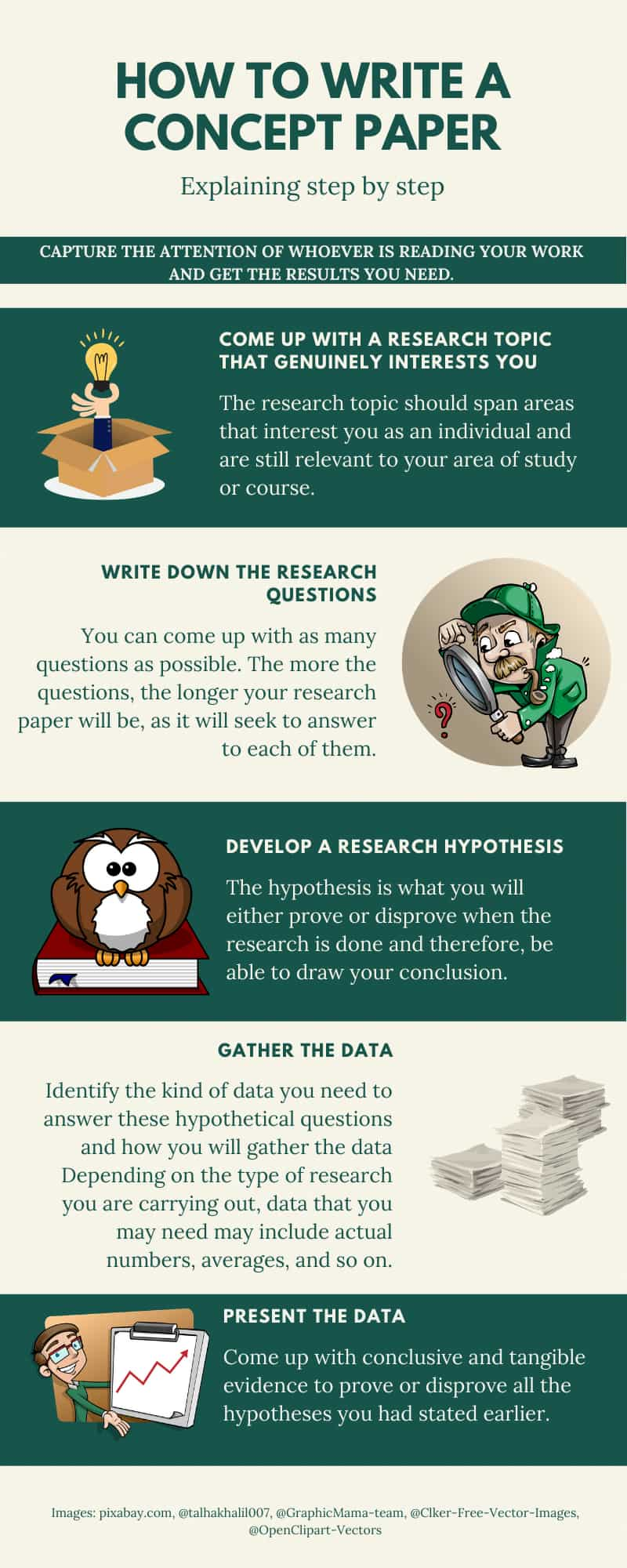
A research paper is usually done at the very last year or semester and is vital for the satisfactory completion of your course. You as the student are required to come up with a topic of research that you find relevant and essential to potentially solve an existing problem or answer a controversial question in your area of study or industry in question.

Dimples Romana, ibinahagi kung paano niya tini-treasure ang mga minuto kasama ang mga anak
Before doing your research or writing your research paper, you will need to draft a catchy summary of what the research is about and how it contributes to the world of academia, and especially with regards to the particular industry in question. This summary is what is known as a concept paper. The concept paper will be read by your lecturer or supervisor who will be tasked to determine the suitability of the research project you want to undertake. Based on their analysis and your prowess in convincing them that it is a worthy and helpful research project, they will either give you the go-ahead to carry on with the project, suggest similar alternative topics you can focus on, or tell you to come up with another project altogether. This article details how to write a concept paper, but first, let us look at what a concept paper is.
Concept paper definition

Citibank credit card: application, benefits and rewards
A concept paper is a document which summarizes what your project is about, why it is important, and how you intend to carry it out. It consists of the topic under research, the hypothesis that you seek to approve or disprove, research questions, data required, and methods of obtaining it. It is sometimes known as a proposal or an abstract. The latter two are usually more detailed than a concept paper but often serve the same purpose, that is, to convince the party evaluating it that the research project is worthwhile.
Depending on the research you are carrying out, your concept paper can range from 2-3 pages for a small research project to up to 20 pages for massive research projects. As for the formatting, the spacing should be double, the font size should be 12, and the font style should preferably be Times New Roman. If you refer to any sources while drafting your concept paper, it is important that you cite them at the end of your document or whenever the citation may be necessary for the process of concept paper writing.

How to apologize to a girl
How to write a concept paper
Writing a concept paper is the first step in writing your research project. A winning concept paper will capture the attention of whoever is reading it and get you the results you need. Below are the steps you need to follow to ensure that your concept paper will get a smile and a nod from the reader.
1. Come up with a research topic that genuinely interests you
The research topic should span areas that interest you as an individual and are still relevant to your area of study or course. How do you come up with a research topic?
How to come up with a research topic
As you studied throughout your junior classes, you may have encountered certain concepts that awoke your curiosity. These may give you ideas of what your research could be about. Alternatively, while randomly reading a newspaper, watching TV, reading books, and so on, you may have come across ideas or concepts that aroused your interests. These can serve as research topics you may consider pursuing. Personal experiences can also be good starting points when you are searching for a topic to write about.

What is an annotation? How to write it? Examples
List all the ideas you can remember or think of that you would be interested in doing a research on. Afterward, choose the area that interests you most in the list you made as the one in which you will carry out your research. Ensure it is a topic that is academically relevant and researchable.
2. Write down the research questions you need to research on depending on the idea you have chosen
You can come up with as many questions as possible. The more the questions, the longer your research paper will be, as it will seek to answer to each of them. The questions can range from:
- Exploratory questions, where you want to find out more about the topic under study,
- Explanatory question, where your aim is to explore the relationship or lack thereof between two or more variables, and
- Descriptive questions such as determining the averages, means, and modes of a variable or variables in the topic under study.

Online jobs Philippines for students: 10 available variants (2020)
3. Develop a research hypothesis from each of the research questions that you have listed
A hypothesis, also known as a thesis or theses in plural, is a tentative, usually informed or educated guess about a certain scenario. It is referred to as ‘an educated or informed guess’ as it is based on some prior knowledge about the topic either by some pre-known theory, or a previous research you may have carried out. The hypothesis is what you will either prove or disprove when the research is done and therefore, be able to draw your conclusion.
4. Identify the kind of data you need to answer these hypothetical questions and how you will gather the data
- Depending on the type of research you are carrying out, data that you may need may include actual numbers, averages, and so on. Data can either be primary or secondary, qualitative or quantitative.
- Primary data is first-hand information obtained from the ground, for example, by carrying out interviews and site visits.
- Secondary data is second-hand information obtained from reading books, watching news, videos, the internet, and other already documented material.
- Qualitative data is based on subjective factors such as people’s opinions, while quantitative data is based on actual numbers and is, therefore, more objective.

13 Filipino Dating Sites: Try Free Legit Dating Now
5. Identify how you will analyze, interpret, and present the data
Come up with conclusive and tangible evidence to prove or disprove all the hypotheses you had stated earlier. Methods of data analysis include the use of statistical analysis such as mean, totals, income, or the general relationship between variables which can be enhanced by the use of graphical methods where possible.
Having developed all the above, you are now ready to come up with your concept paper, which will detail each of the steps outlined. The following is a guideline on how to structure your ideas for the perfect concept paper.
How to structure your concept paper
Here are the major elements of a concept paper format:
1. The title page
You should begin with a title that fully summarizes what the project you are carrying out is about. Avoid being wordy and stick to the main point.
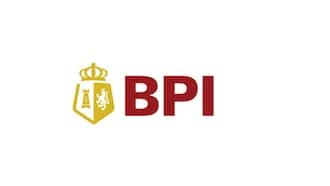
BPI credit card application 2023: process, requirements, status
2. Introduction and statement of the problem
This serves as the most important part of the concept paper. You must be seeking to add value and convince the reader that you are doing so. For example, your research should seek to solve an existing problem or provide further insights into a scarcely researched topic. The problem should be clear. Why would you want to investigate the topic under study, and how your research will be helpful in achieving this? Herein, you need to provide the evidence that the research you need to carry out is necessary in that it has not been carried out before or has not been adequately done. Here are some questions that may help you nail this element:
- What is the problem?
- Why do you feel that it is important?
- How does your study relate to or add to research that has already been done?
3. Value of the study

Call center interview: how to pass in 2020? Tips and tricks
Outline specific groups of people who the study may benefit and how it will benefit them.
4. A preliminary literature review
You need to back up your passion for the topic under research with solid literature that supports the topic, for example, literature that supports the fact that further research needs to be carried out in that area. You need to show that there exists an information gap which your research seeks to fill. The wider the variety of literature review you have carried out, the more solid and convincing your concept paper will be.
5. State the research goals or objectives
This is a broad statement or statements of what the research seeks to achieve. It should start with ‘to’ and answer the questions who, what, when, which, or how.
6. Write down all the research questions
These are important as they will direct you on every research area, for example, the type of data to collect and how to analyze it. Make sure you have exhausted all the questions for the research to be complete.

What is SOGIE bill in 2023? Meaning explained and Philippines update
7. The research hypothesis
The research hypotheses stem from the research topic or the research questions and are, therefore, easy to draft. They are a statement of the situation you anticipate based on some prior knowledge you have, even before you carry out the research. The research seeks to find out if these hypotheses are true or not. There should be a positive and a negative hypothesis for each statement given. A positive hypothesis agrees with the statement in question while a negative hypothesis opposes it. At the end of the research paper, you will either accept or reject your positive hypothesis based on your findings.
8. State the methodology you intend to use
The research methodology states the ‘how’ of carrying out the research. It details the research design, that is, what kind of research you intend to carry out. You can either carry out:

Get your dream job as a call center agent job in a few steps
- An exploratory design that seeks to expound on the area of study that you have an idea in, in order to understand it better.
- An explanatory design that seeks to carry out an in-depth study on a certain idea that was not tackled in-depth. It mostly requires the use of qualitative methods of data collection.
- A descriptive research that seeks to find out the relationship between two variables of data you need. It uses analyses methods such as mean and mode.
9. A timeline for completion of each element of the research project
Undertaking a research can take a very long time if not well planned for, and it is, therefore, important to lay out just how much time you may need to complete each element of the research project and ultimately the whole project. In this section, you need to set a time frame that is realistic.

Marriage certificate Philippines: All you need to know
10. Outline citations
Always remember to give credit to any sources you may have sourced your information from. This can be done within the document or at the end of the concept paper.
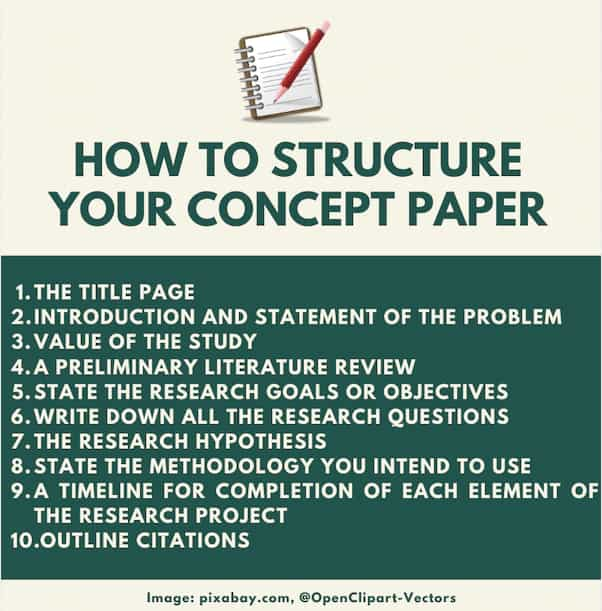
Concept paper example
Below is an example of a concept paper how to write. It will give you a detailed picture of what to include in your concept paper and ease the process of coming up with your own.
THE ROLE THAT QUALITY PLAYS IN THE PERFORMANCE OF FOOD PRODUCING FIRMS IN PAKISTANI
Introduction
Of late, there have been so many cases of food-related illnesses that are being directly associated with the low quality of food products being released to the market by the many food processing firms. It is clear that the quality of products that these firms are producing is below the industry mark. Surprisingly, these food firms which are already losing their reputation still seem to be blossoming. There is a general perception that quality affects the performance of firms and this ironic trend, therefore, begs the question as to just how vital quality is in the production process.

Havana outfit female: Trends of 2020 (photos)
Statement of the problem
This study seeks to answer the question on just how much the quality considerations of a firm affect its performance in terms of factors such as the ability to make more sales, maintain profit, as well as remain in the market. Is quality that much a factor as we all imagine it to be? If it is, why are these firms still doing so well, and if it is not what other factors are causing these firms to continue to prosper? Have we lost the quality battle by offering sub-standard products to our people, and should we reconsider our quality restrictions?
It has been widely agreed that quality is a factor that firms need to consider in order to compete in the global market (Paiva, 2013). Is this however the scenario on the ground and does quality play such a great role in the performance of food producing firms?

Wedding checklist Philippines 2020: what to start with your preparation?
Value of the study
The findings for the study will be helpful to the following parties:
- Quality regulatory bodies that will be able to determine the quality gap that exists and take necessary action.
- Researchers who will identify further areas of study as will be outlined in this research and hence lead to an increase in the body of knowledge.
Definition of variables
What is quality?
In this study, we will define quality as the ability of a product to perform suitably as per expectations (Reid & Sanders 2012). The study shall focus on the four main quality components including Quality planning, control, assurance, and improvement, and how each affects the performance of a firm when well implemented.
What is performance?
In this study, we will define performance as the ability to meet and /or exceed set standards. Examples of performance standards include sales levels, brand image, reduced rework rates, and customer retention rates.

BIR Form 1905: how to fill up in 2023? Sample, latest version, requirements
A brief Literature Review
Many documented texts agree that there is a relationship between quality considerations and the performance of firms. According to Garvin 1984, quality is based on innate excellence, recognizable on through experience. Abbot describes it as a measurable variable, and in another study, quality is subjective and individual based (Maio 2007). According to Sower 2010, quality refers to the conformance to prior set specifications. The final argument is that quality is based on cost and prices (Jones 2014).
The above scholars argue that quality is essential in the performance of a firm. The literature reviews however fall short as they fail to answer a few questions which this study paper will seek to outline. These are:
- To what extent quality actually affects performance, and
- Which approach firms use to measure quality and how these approaches affect their performance.
Research objectives
This research paper will be guided by the following objectives;

Certificate of Employment request letter: format, sample, template
- To find out the systems that food producing firms in the country have put in place to guarantee quality of their products.
- To determine the extent to which these quality systems affect their performance.
Research hypothesis
H0. Adherence to quality management system is integral to the performance of food producing firms.
H1. Adherence to quality management systems is not integral to the performance of food processing firms.
Research methodology
Research design
This will be a descriptive study analyzing different firms, the kinds of quality systems they have in place, and the relationship between these quality systems and the performance of the firms in question.
Population of study
The study will involve a sample of 35 food producing firms based in the capital, irrespective of their size or age.
Data collection
Data used will be primary data collected by use of questionnaires to be filled by personnel in the Operations Department of the various firms or other relevant department. The questions will be broad and detailed, seeking to draw information on the types of quality systems that the firms have put in place. For this study, we will focus on the four main quality components including Quality planning, quality control, quality assurance, and quality improvement. Details of their performance in terms of factors such as sales revenues will also be sought. Data on performance will also be sourced from secondary sources such as company financial statements and sales records, some of which are available online.

What is Conyo? 25 funny words list, lines and phrases meaning
Data analyses and interpretation
The data of the two variables collected, Quality, (X), and p
Performance, (Y), will be used to draw up a regression analysis to determine the strength as well as the nature of the relationship between the two variables. A conclusion will then be drawn from the resulting findings.
The project is expected to be completed in 13 weeks with the following as the timeline for each part of the project:
- Introduction and literature review: 3 weeks
- Research methodology: 5 weeks
- Data analysis, data interpretation, and presentation: 2 weeks
- Summary, conclusion, and recommendations: 2 weeks
- Polishing up the work for submission: 1 week
- American Society for Quality. (2015, January 13). Quality Assurance. Quality Engineering .
- Besterfield Dale .H, D... (2011). Total Quality Management (Revised ed.). Delhi, CRC Noida, India: Pearson.
- Carton, R. B. (2006). Measuring Organizational performance: Metrics for entrepreneurship and strategic management research. Northampton, Massachusetts, United States of America: Edwards Elgar Publishing.
- Ciotti, G. (2013, May 22nd). Help Scout. Retrieved February 23rd, 2015, from Help scout website: http://www.helpscout.net/blog/customer-satisfaction/
- Crosby, P. B. (1995). Quality Without Tears:The art of Hassle Free Management. (J. H. David E.Fogarty, Ed.) Town Penn Plaza, New York, United States of America :McGraw- Hill.
- David J Ketchen, J. c. (2004). Improving Firm Performance by matching strategic Decision-Making processes to competitive Dynamics. The Academy of Management Executive, 18 (4), 29-43.
- Et.al, J. G. (2005).Research in social Stratification and Mobility (Vol. 2). (K. T. Leicht, Ed.) Amsterdam, Netherlands: Elsevier.
- Frank M. Gryna, B. G. (2005). Juran, Quality and a century of Improvement (15th ed.). (K. S. Stephens, Ed.) Milwaukee, Winsconsin, United States of America: ASQ Press

How to open BDO savings account: online application and requirements (2021)
After following the above outline, you can be sure to submit a convincing concept paper for your research project to be approved. Finally, remember that the concept paper is based on facts and your personal opinions are not allowed. Ensure that your topic is researchable through any academic means such as the use of libraries, interviews, internet, and the like. The research must add value and be useful in the academic fraternity and not be casual. It must have a question or questions that are very specific and answerable by carrying out the research. It should have at least one hypothesis, and the data you need must obtainable in a cost-effective way. Of importance is to provide proper citation for all your work. I trust that you are now well versed with how to write a concept paper that you will be proud of.
Source: KAMI.com.gh
So much is at stake in writing a conclusion. This is, after all, your last chance to persuade your readers to your point of view, to impress yourself upon them as a writer and thinker. And the impression you create in your conclusion will shape the impression that stays with your readers after they've finished the essay.
The end of an essay should therefore convey a sense of completeness and closure as well as a sense of the lingering possibilities of the topic, its larger meaning, its implications: the final paragraph should close the discussion without closing it off.
To establish a sense of closure, you might do one or more of the following:
- Conclude by linking the last paragraph to the first, perhaps by reiterating a word or phrase you used at the beginning.
- Conclude with a sentence composed mainly of one-syllable words. Simple language can help create an effect of understated drama.
- Conclude with a sentence that's compound or parallel in structure; such sentences can establish a sense of balance or order that may feel just right at the end of a complex discussion.
To close the discussion without closing it off, you might do one or more of the following:
- Conclude with a quotation from or reference to a primary or secondary source, one that amplifies your main point or puts it in a different perspective. A quotation from, say, the novel or poem you're writing about can add texture and specificity to your discussion; a critic or scholar can help confirm or complicate your final point. For example, you might conclude an essay on the idea of home in James Joyce's short story collection, Dubliners , with information about Joyce's own complex feelings towards Dublin, his home. Or you might end with a biographer's statement about Joyce's attitude toward Dublin, which could illuminate his characters' responses to the city. Just be cautious, especially about using secondary material: make sure that you get the last word.
- Conclude by setting your discussion into a different, perhaps larger, context. For example, you might end an essay on nineteenth-century muckraking journalism by linking it to a current news magazine program like 60 Minutes .
- Conclude by redefining one of the key terms of your argument. For example, an essay on Marx's treatment of the conflict between wage labor and capital might begin with Marx's claim that the "capitalist economy is . . . a gigantic enterprise of dehumanization "; the essay might end by suggesting that Marxist analysis is itself dehumanizing because it construes everything in economic -- rather than moral or ethical-- terms.
- Conclude by considering the implications of your argument (or analysis or discussion). What does your argument imply, or involve, or suggest? For example, an essay on the novel Ambiguous Adventure , by the Senegalese writer Cheikh Hamidou Kane, might open with the idea that the protagonist's development suggests Kane's belief in the need to integrate Western materialism and Sufi spirituality in modern Senegal. The conclusion might make the new but related point that the novel on the whole suggests that such an integration is (or isn't) possible.
Finally, some advice on how not to end an essay:
- Don't simply summarize your essay. A brief summary of your argument may be useful, especially if your essay is long--more than ten pages or so. But shorter essays tend not to require a restatement of your main ideas.
- Avoid phrases like "in conclusion," "to conclude," "in summary," and "to sum up." These phrases can be useful--even welcome--in oral presentations. But readers can see, by the tell-tale compression of the pages, when an essay is about to end. You'll irritate your audience if you belabor the obvious.
- Resist the urge to apologize. If you've immersed yourself in your subject, you now know a good deal more about it than you can possibly include in a five- or ten- or 20-page essay. As a result, by the time you've finished writing, you may be having some doubts about what you've produced. (And if you haven't immersed yourself in your subject, you may be feeling even more doubtful about your essay as you approach the conclusion.) Repress those doubts. Don't undercut your authority by saying things like, "this is just one approach to the subject; there may be other, better approaches. . ."
Copyright 1998, Pat Bellanca, for the Writing Center at Harvard University
When you choose to publish with PLOS, your research makes an impact. Make your work accessible to all, without restrictions, and accelerate scientific discovery with options like preprints and published peer review that make your work more Open.
- PLOS Biology
- PLOS Climate
- PLOS Complex Systems
- PLOS Computational Biology
- PLOS Digital Health
- PLOS Genetics
- PLOS Global Public Health
- PLOS Medicine
- PLOS Mental Health
- PLOS Neglected Tropical Diseases
- PLOS Pathogens
- PLOS Sustainability and Transformation
- PLOS Collections
- How to Write Discussions and Conclusions

The discussion section contains the results and outcomes of a study. An effective discussion informs readers what can be learned from your experiment and provides context for the results.
What makes an effective discussion?
When you’re ready to write your discussion, you’ve already introduced the purpose of your study and provided an in-depth description of the methodology. The discussion informs readers about the larger implications of your study based on the results. Highlighting these implications while not overstating the findings can be challenging, especially when you’re submitting to a journal that selects articles based on novelty or potential impact. Regardless of what journal you are submitting to, the discussion section always serves the same purpose: concluding what your study results actually mean.
A successful discussion section puts your findings in context. It should include:
- the results of your research,
- a discussion of related research, and
- a comparison between your results and initial hypothesis.
Tip: Not all journals share the same naming conventions.
You can apply the advice in this article to the conclusion, results or discussion sections of your manuscript.
Our Early Career Researcher community tells us that the conclusion is often considered the most difficult aspect of a manuscript to write. To help, this guide provides questions to ask yourself, a basic structure to model your discussion off of and examples from published manuscripts.

Questions to ask yourself:
- Was my hypothesis correct?
- If my hypothesis is partially correct or entirely different, what can be learned from the results?
- How do the conclusions reshape or add onto the existing knowledge in the field? What does previous research say about the topic?
- Why are the results important or relevant to your audience? Do they add further evidence to a scientific consensus or disprove prior studies?
- How can future research build on these observations? What are the key experiments that must be done?
- What is the “take-home” message you want your reader to leave with?
How to structure a discussion
Trying to fit a complete discussion into a single paragraph can add unnecessary stress to the writing process. If possible, you’ll want to give yourself two or three paragraphs to give the reader a comprehensive understanding of your study as a whole. Here’s one way to structure an effective discussion:

Writing Tips
While the above sections can help you brainstorm and structure your discussion, there are many common mistakes that writers revert to when having difficulties with their paper. Writing a discussion can be a delicate balance between summarizing your results, providing proper context for your research and avoiding introducing new information. Remember that your paper should be both confident and honest about the results!

- Read the journal’s guidelines on the discussion and conclusion sections. If possible, learn about the guidelines before writing the discussion to ensure you’re writing to meet their expectations.
- Begin with a clear statement of the principal findings. This will reinforce the main take-away for the reader and set up the rest of the discussion.
- Explain why the outcomes of your study are important to the reader. Discuss the implications of your findings realistically based on previous literature, highlighting both the strengths and limitations of the research.
- State whether the results prove or disprove your hypothesis. If your hypothesis was disproved, what might be the reasons?
- Introduce new or expanded ways to think about the research question. Indicate what next steps can be taken to further pursue any unresolved questions.
- If dealing with a contemporary or ongoing problem, such as climate change, discuss possible consequences if the problem is avoided.
- Be concise. Adding unnecessary detail can distract from the main findings.

Don’t
- Rewrite your abstract. Statements with “we investigated” or “we studied” generally do not belong in the discussion.
- Include new arguments or evidence not previously discussed. Necessary information and evidence should be introduced in the main body of the paper.
- Apologize. Even if your research contains significant limitations, don’t undermine your authority by including statements that doubt your methodology or execution.
- Shy away from speaking on limitations or negative results. Including limitations and negative results will give readers a complete understanding of the presented research. Potential limitations include sources of potential bias, threats to internal or external validity, barriers to implementing an intervention and other issues inherent to the study design.
- Overstate the importance of your findings. Making grand statements about how a study will fully resolve large questions can lead readers to doubt the success of the research.
Snippets of Effective Discussions:
Consumer-based actions to reduce plastic pollution in rivers: A multi-criteria decision analysis approach
Identifying reliable indicators of fitness in polar bears
- How to Write a Great Title
- How to Write an Abstract
- How to Write Your Methods
- How to Report Statistics
- How to Edit Your Work
The contents of the Peer Review Center are also available as a live, interactive training session, complete with slides, talking points, and activities. …
The contents of the Writing Center are also available as a live, interactive training session, complete with slides, talking points, and activities. …
There’s a lot to consider when deciding where to submit your work. Learn how to choose a journal that will help your study reach its audience, while reflecting your values as a researcher…
- Affiliate Program

- UNITED STATES
- 台灣 (TAIWAN)
- TÜRKIYE (TURKEY)
- Academic Editing Services
- - Research Paper
- - Journal Manuscript
- - Dissertation
- - College & University Assignments
- Admissions Editing Services
- - Application Essay
- - Personal Statement
- - Recommendation Letter
- - Cover Letter
- - CV/Resume
- Business Editing Services
- - Business Documents
- - Report & Brochure
- - Website & Blog
- Writer Editing Services
- - Script & Screenplay
- Our Editors
- Client Reviews
- Editing & Proofreading Prices
- Wordvice Points
- Partner Discount
- Plagiarism Checker
- APA Citation Generator
- MLA Citation Generator
- Chicago Citation Generator
- Vancouver Citation Generator
- - APA Style
- - MLA Style
- - Chicago Style
- - Vancouver Style
- Writing & Editing Guide
- Academic Resources
- Admissions Resources
How to Write a Research Paper Conclusion Section
What is a conclusion in a research paper?
The conclusion in a research paper is the final paragraph or two in a research paper. In scientific papers, the conclusion usually follows the Discussion section , summarizing the importance of the findings and reminding the reader why the work presented in the paper is relevant.
However, it can be a bit confusing to distinguish the conclusion section/paragraph from a summary or a repetition of your findings, your own opinion, or the statement of the implications of your work. In fact, the conclusion should contain a bit of all of these other parts but go beyond it—but not too far beyond!
The structure and content of the conclusion section can also vary depending on whether you are writing a research manuscript or an essay. This article will explain how to write a good conclusion section, what exactly it should (and should not) contain, how it should be structured, and what you should avoid when writing it.
Table of Contents:
What does a good conclusion section do, what to include in a research paper conclusion.
- Conclusion in an Essay
- Research Paper Conclusion
- Conclusion Paragraph Outline and Example
- What Not to Do When Writing a Conclusion
The conclusion of a research paper has several key objectives. It should:
- Restate your research problem addressed in the introduction section
- Summarize your main arguments, important findings, and broader implications
- Synthesize key takeaways from your study
The specific content in the conclusion depends on whether your paper presents the results of original scientific research or constructs an argument through engagement with previously published sources.
You presented your general field of study to the reader in the introduction section, by moving from general information (the background of your work, often combined with a literature review ) to the rationale of your study and then to the specific problem or topic you addressed, formulated in the form of the statement of the problem in research or the thesis statement in an essay.
In the conclusion section, in contrast, your task is to move from your specific findings or arguments back to a more general depiction of how your research contributes to the readers’ understanding of a certain concept or helps solve a practical problem, or fills an important gap in the literature. The content of your conclusion section depends on the type of research you are doing and what type of paper you are writing. But whatever the outcome of your work is, the conclusion is where you briefly summarize it and place it within a larger context. It could be called the “take-home message” of the entire paper.
What to summarize in the conclusion
Your conclusion section needs to contain a very brief summary of your work , a very brief summary of the main findings of your work, and a mention of anything else that seems relevant when you now look at your work from a bigger perspective, even if it was not initially listed as one of your main research questions. This could be a limitation, for example, a problem with the design of your experiment that either needs to be considered when drawing any conclusions or that led you to ask a different question and therefore draw different conclusions at the end of your study (compared to when you started out).
Once you have reminded the reader of what you did and what you found, you need to go beyond that and also provide either your own opinion on why your work is relevant (and for whom, and how) or theoretical or practical implications of the study , or make a specific call for action if there is one to be made.
How to Write an Essay Conclusion
Academic essays follow quite different structures than their counterparts in STEM and the natural sciences. Humanities papers often have conclusion sections that are much longer and contain more detail than scientific papers. There are three main types of academic essay conclusions.
Summarizing conclusion
The most typical conclusion at the end of an analytical/explanatory/argumentative essay is a summarizing conclusion . This is, as the name suggests, a clear summary of the main points of your topic and thesis. Since you might have gone through a number of different arguments or subtopics in the main part of your essay, you need to remind the reader again what those were, how they fit into each other, and how they helped you develop or corroborate your hypothesis.
For an essay that analyzes how recruiters can hire the best candidates in the shortest time or on “how starving yourself will increase your lifespan, according to science”, a summary of all the points you discussed might be all you need. Note that you should not exactly repeat what you said earlier, but rather highlight the essential details and present those to your reader in a different way.
Externalizing conclusion
If you think that just reminding the reader of your main points is not enough, you can opt for an externalizing conclusion instead, that presents new points that were not presented in the paper so far. These new points can be additional facts and information or they can be ideas that are relevant to the topic and have not been mentioned before.
Such a conclusion can stimulate your readers to think about your topic or the implications of your analysis in a whole new way. For example, at the end of a historical analysis of a specific event or development, you could direct your reader’s attention to some current events that were not the topic of your essay but that provide a different context for your findings.
Editorial conclusion
In an editorial conclusion , another common type of conclusion that you will find at the end of papers and essays, you do not add new information but instead present your own experiences or opinions on the topic to round everything up. What makes this type of conclusion interesting is that you can choose to agree or disagree with the information you presented in your paper so far. For example, if you have collected and analyzed information on how a specific diet helps people lose weight, you can nevertheless have your doubts on the sustainability of that diet or its practicability in real life—if such arguments were not included in your original thesis and have therefore not been covered in the main part of your paper, the conclusion section is the place where you can get your opinion across.
How to Conclude an Empirical Research Paper
An empirical research paper is usually more concise and succinct than an essay, because, if it is written well, it focuses on one specific question, describes the method that was used to answer that one question, describes and explains the results, and guides the reader in a logical way from the introduction to the discussion without going on tangents or digging into not absolutely relevant topics.
Summarize the findings
In a scientific paper, you should include a summary of the findings. Don’t go into great detail here (you will have presented your in-depth results and discussion already), but do clearly express the answers to the research questions you investigated.
Describe your main findings, even if they weren’t necessarily the ones anticipated, and explain the conclusion they led you to. Explain these findings in as few words as possible.
Instead of beginning with “ In conclusion, in this study, we investigated the effect of stress on the brain using fMRI …”, you should try to find a way to incorporate the repetition of the essential (and only the essential) details into the summary of the key points. “ The findings of this fMRI study on the effect of stress on the brain suggest that …” or “ While it has been known for a long time that stress has an effect on the brain, the findings of this fMRI study show that, surprisingly… ” would be better ways to start a conclusion.
You should also not bring up new ideas or present new facts in the conclusion of a research paper, but stick to the background information you have presented earlier, to the findings you have already discussed, and the limitations and implications you have already described. The one thing you can add here is a practical recommendation that you haven’t clearly stated before—but even that one needs to follow logically from everything you have already discussed in the discussion section.
Discuss the implications
After summing up your key arguments or findings, conclude the paper by stating the broader implications of the research , whether in methods , approach, or findings. Express practical or theoretical takeaways from your paper. This often looks like a “call to action” or a final “sales pitch” that puts an exclamation point on your paper.
If your research topic is more theoretical in nature, your closing statement should express the significance of your argument—for example, in proposing a new understanding of a topic or laying the groundwork for future research.
Future research example
Future research into education standards should focus on establishing a more detailed picture of how novel pedagogical approaches impact young people’s ability to absorb new and difficult concepts. Moreover, observational studies are needed to gain more insight into how specific teaching models affect the retention of relationships and facts—for instance, how inquiry-based learning and its emphasis on lateral thinking can be used as a jumping-off point for more holistic classroom approaches.
Research Conclusion Example and Outline
Let’s revisit the study on the effect of stress on the brain we mentioned before and see what the common structure for a conclusion paragraph looks like, in three steps. Following these simple steps will make it easy for you to wrap everything up in one short paragraph that contains all the essential information:
One: Short summary of what you did, but integrated into the summary of your findings:
While it has been known for a long time that stress has an effect on the brain, the findings of this fMRI study in 25 university students going through mid-term exams show that, surprisingly, one’s attitude to the experienced stress significantly modulates the brain’s response to it.
Note that you don’t need to repeat any methodological or technical details here—the reader has been presented with all of these before, they have read your results section and the discussion of your results, and even (hopefully!) a discussion of the limitations and strengths of your paper. The only thing you need to remind them of here is the essential outcome of your work.
Two: Add implications, and don’t forget to specify who this might be relevant for:
Students could be considered a specific subsample of the general population, but earlier research shows that the effect that exam stress has on their physical and mental health is comparable to the effects of other types of stress on individuals of other ages and occupations. Further research into practical ways of modulating not only one’s mental stress response but potentially also one’s brain activity (e.g., via neurofeedback training) are warranted.
This is a “research implication”, and it is nicely combined with a mention of a potential limitation of the study (the student sample) that turns out not to be a limitation after all (because earlier research suggests we can generalize to other populations). If there already is a lot of research on neurofeedback for stress control, by the way, then this should have been discussed in your discussion section earlier and you wouldn’t say such studies are “warranted” here but rather specify how your findings could inspire specific future experiments or how they should be implemented in existing applications.
Three: The most important thing is that your conclusion paragraph accurately reflects the content of your paper. Compare it to your research paper title , your research paper abstract , and to your journal submission cover letter , in case you already have one—if these do not all tell the same story, then you need to go back to your paper, start again from the introduction section, and find out where you lost the logical thread. As always, consistency is key.
Problems to Avoid When Writing a Conclusion
- Do not suddenly introduce new information that has never been mentioned before (unless you are writing an essay and opting for an externalizing conclusion, see above). The conclusion section is not where you want to surprise your readers, but the take-home message of what you have already presented.
- Do not simply copy your abstract, the conclusion section of your abstract, or the first sentence of your introduction, and put it at the end of the discussion section. Even if these parts of your paper cover the same points, they should not be identical.
- Do not start the conclusion with “In conclusion”. If it has its own section heading, that is redundant, and if it is the last paragraph of the discussion section, it is inelegant and also not really necessary. The reader expects you to wrap your work up in the last paragraph, so you don’t have to announce that. Just look at the above example to see how to start a conclusion in a natural way.
- Do not forget what your research objectives were and how you initially formulated the statement of the problem in your introduction section. If your story/approach/conclusions changed because of methodological issues or information you were not aware of when you started, then make sure you go back to the beginning and adapt your entire story (not just the ending).
Consider Receiving Academic Editing Services
When you have arrived at the conclusion of your paper, you might want to head over to Wordvice AI’s AI Writing Assistant to receive a free grammar check for any academic content.
After drafting, you can also receive English editing and proofreading services , including paper editing services for your journal manuscript. If you need advice on how to write the other parts of your research paper , or on how to make a research paper outline if you are struggling with putting everything you did together, then head over to the Wordvice academic resources pages , where we have a lot more articles and videos for you.
- How to Cite
- Language & Lit
- Rhyme & Rhythm
- The Rewrite
- Search Glass
What Are the Steps to Writing a Concept Essay?
The purpose of a concept essay is to inform your reader on a specific topic: “Successful explanatory writing presents information confidently and efficiently, usually with the purpose of educating the reader about a subject," Rise B. Axelrod and Charles R. Cooper explain in "The St. Martin's Guide to Writing." A concept essay serves to explain, not influence. You don’t take certain stance or point of view regarding your subject. Even if you tackle a controversial theme, explain the facets of a controversy rather than taking a side.
Find a Subject
Often, you will be assigned a topic on which to write. However, you may get the opportunity to choose from a wide range of subjects or to come up with your own topic. Look for something that interests you. If you are interested in the theme, you will be more likely to write in a way that makes others interested as well. Concept essays themes tend to be more abstract than the topics for other essays. For example, you may be asked to write about the racism, communication or wisdom.
Think about what you already know about your subject and then find out what you don’t know. You are educating someone about a topic, so make sure you know as much as possible about it. Once you have done your research, you will decide how much of it to use. You don’t want to put every piece of information in the essay, but you need enough detail so that someone unfamiliar with the concept will be able to understand it once he has read your paper.
Determine the audience for your paper. According to the University of North Carolina at Chapel Hill’s Writing Center, knowing your audience “can help you make good decisions about what material to include, in what order to organize your ideas, and how best to support your argument.”
Organize your ideas by putting them in an outline. The Purdue Online Writing Lab discusses the importance of creating an outline and gives ideas on how to get started (see Resources section). By organizing your ideas, you will start to get the overall form of your paper. You can see which ideas are alike and should be grouped together. Also, you will see which ones do not fit and should be eliminated.
Introduction
The introductory paragraph announces your subject and gives an indication of the important points within the essay. Also, your introduction should contain your thesis statement. A thesis is a sentence or two that states the central idea of your paper. The thesis allows readers to clearly understand the purpose of your essay.
Body Paragraphs
Compose body paragraphs that support your thesis. Each paragraph conveys one main point. That main point is stated in the topic sentence of the paragraph. The rest of the paragraph should support that topic sentence, and all paragraphs should support your overall thesis.
Remind the reader of the main idea of your essay. A conclusion summarizes the main points of your paper. Be careful to word this in a new way so your essay does not seem repetitive.
Editing and Revising
When your first draft is completed, edit your work. Check to see that the essay stays on topic from start to finish. Make sure the information is presented in a logical way. Verify that each paragraph stays focused on a central idea. Look for spelling and grammatical errors.
- "The St. Martin's Guide to Writing, 7th ed.;" Rise B. Axelrod and Charles R. Cooper; 2004
Shelia Odak has over 10 years writing and editing experience for consumer and trade publications including "Radio/TV Interview Report." She has worked for over nine years in education and holds a Ph.D. from Georgia State University. Odak writes on a range of topics including education, literature and frugal living.
- PRO Courses Guides New Tech Help Pro Expert Videos About wikiHow Pro Upgrade Sign In
- EDIT Edit this Article
- EXPLORE Tech Help Pro About Us Random Article Quizzes Request a New Article Community Dashboard This Or That Game Popular Categories Arts and Entertainment Artwork Books Movies Computers and Electronics Computers Phone Skills Technology Hacks Health Men's Health Mental Health Women's Health Relationships Dating Love Relationship Issues Hobbies and Crafts Crafts Drawing Games Education & Communication Communication Skills Personal Development Studying Personal Care and Style Fashion Hair Care Personal Hygiene Youth Personal Care School Stuff Dating All Categories Arts and Entertainment Finance and Business Home and Garden Relationship Quizzes Cars & Other Vehicles Food and Entertaining Personal Care and Style Sports and Fitness Computers and Electronics Health Pets and Animals Travel Education & Communication Hobbies and Crafts Philosophy and Religion Work World Family Life Holidays and Traditions Relationships Youth
- Browse Articles
- Learn Something New
- Quizzes Hot
- This Or That Game New
- Train Your Brain
- Explore More
- Support wikiHow
- About wikiHow
- Log in / Sign up
- Education and Communications
- College University and Postgraduate
- Academic Writing
- Research Papers
How to Write a Conclusion for a Research Paper
Last Updated: June 29, 2023 Approved
This article was co-authored by Christopher Taylor, PhD . Christopher Taylor is an Adjunct Assistant Professor of English at Austin Community College in Texas. He received his PhD in English Literature and Medieval Studies from the University of Texas at Austin in 2014. wikiHow marks an article as reader-approved once it receives enough positive feedback. This article received 42 testimonials and 82% of readers who voted found it helpful, earning it our reader-approved status. This article has been viewed 2,256,103 times.
The conclusion of a research paper needs to summarize the content and purpose of the paper without seeming too wooden or dry. Every basic conclusion must share several key elements, but there are also several tactics you can play around with to craft a more effective conclusion and several you should avoid to prevent yourself from weakening your paper's conclusion. Here are some writing tips to keep in mind when creating a conclusion for your next research paper.
Sample Conclusions
Writing a basic conclusion.

- Do not spend a great amount of time or space restating your topic.
- A good research paper will make the importance of your topic apparent, so you do not need to write an elaborate defense of your topic in the conclusion.
- Usually a single sentence is all you need to restate your topic.
- An example would be if you were writing a paper on the epidemiology of infectious disease, you might say something like "Tuberculosis is a widespread infectious disease that affects millions of people worldwide every year."
- Yet another example from the humanities would be a paper about the Italian Renaissance: "The Italian Renaissance was an explosion of art and ideas centered around artists, writers, and thinkers in Florence."

- A thesis is a narrowed, focused view on the topic at hand.
- This statement should be rephrased from the thesis you included in your introduction. It should not be identical or too similar to the sentence you originally used.
- Try re-wording your thesis statement in a way that complements your summary of the topic of your paper in your first sentence of your conclusion.
- An example of a good thesis statement, going back to the paper on tuberculosis, would be "Tuberculosis is a widespread disease that affects millions of people worldwide every year. Due to the alarming rate of the spread of tuberculosis, particularly in poor countries, medical professionals are implementing new strategies for the diagnosis, treatment, and containment of this disease ."

- A good way to go about this is to re-read the topic sentence of each major paragraph or section in the body of your paper.
- Find a way to briefly restate each point mentioned in each topic sentence in your conclusion. Do not repeat any of the supporting details used within your body paragraphs.
- Under most circumstances, you should avoid writing new information in your conclusion. This is especially true if the information is vital to the argument or research presented in your paper.
- For example, in the TB paper you could summarize the information. "Tuberculosis is a widespread disease that affects millions of people worldwide. Due to the alarming rate of the spread of tuberculosis, particularly in poor countries, medical professionals are implementing new strategies for the diagnosis, treatment, and containment of this disease. In developing countries, such as those in Africa and Southeast Asia, the rate of TB infections is soaring. Crowded conditions, poor sanitation, and lack of access to medical care are all compounding factors in the spread of the disease. Medical experts, such as those from the World Health Organization are now starting campaigns to go into communities in developing countries and provide diagnostic testing and treatments. However, the treatments for TB are very harsh and have many side effects. This leads to patient non-compliance and spread of multi-drug resistant strains of the disease."

- Note that this is not needed for all research papers.
- If you already fully explained what the points in your paper mean or why they are significant, you do not need to go into them in much detail in your conclusion. Simply restating your thesis or the significance of your topic should suffice.
- It is always best practice to address important issues and fully explain your points in the body of your paper. The point of a conclusion to a research paper is to summarize your argument for the reader and, perhaps, to call the reader to action if needed.

- Note that a call for action is not essential to all conclusions. A research paper on literary criticism, for instance, is less likely to need a call for action than a paper on the effect that television has on toddlers and young children.
- A paper that is more likely to call readers to action is one that addresses a public or scientific need. Let's go back to our example of tuberculosis. This is a very serious disease that is spreading quickly and with antibiotic-resistant forms.
- A call to action in this research paper would be a follow-up statement that might be along the lines of "Despite new efforts to diagnose and contain the disease, more research is needed to develop new antibiotics that will treat the most resistant strains of tuberculosis and ease the side effects of current treatments."

- For example, if you are writing a history paper, then you might discuss how the historical topic you discussed matters today. If you are writing about a foreign country, then you might use the conclusion to discuss how the information you shared may help readers understand their own country.
Making Your Conclusion as Effective as Possible

- Since this sort of conclusion is so basic, you must aim to synthesize the information rather than merely summarizing it.
- Instead of merely repeating things you already said, rephrase your thesis and supporting points in a way that ties them all together.
- By doing so, you make your research paper seem like a "complete thought" rather than a collection of random and vaguely related ideas.

- Ask a question in your introduction. In your conclusion, restate the question and provide a direct answer.
- Write an anecdote or story in your introduction but do not share the ending. Instead, write the conclusion to the anecdote in the conclusion of your paper.
- For example, if you wanted to get more creative and put a more humanistic spin on a paper on tuberculosis, you might start your introduction with a story about a person with the disease, and refer to that story in your conclusion. For example, you could say something like this before you re-state your thesis in your conclusion: "Patient X was unable to complete the treatment for tuberculosis due to severe side effects and unfortunately succumbed to the disease."
- Use the same concepts and images introduced in your introduction in your conclusion. The images may or may not appear at other points throughout the research paper.

- Include enough information about your topic to back the statement up but do not get too carried away with excess detail.
- If your research did not provide you with a clear-cut answer to a question posed in your thesis, do not be afraid to indicate as much.
- Restate your initial hypothesis and indicate whether you still believe it or if the research you performed has begun swaying your opinion.
- Indicate that an answer may still exist and that further research could shed more light on the topic at hand.

- This may not be appropriate for all types of research papers. Most research papers, such as one on effective treatment for diseases, will have the information to make the case for a particular argument already in the paper.
- A good example of a paper that might ask a question of the reader in the ending is one about a social issue, such as poverty or government policy.
- Ask a question that will directly get at the heart or purpose of the paper. This question is often the same question, or some version of it, that you may have started with when you began your research.
- Make sure that the question can be answered by the evidence presented in your paper.
- If desired you can briefly summarize the answer after stating the question. You could also leave the question hanging for the reader to answer, though.

- Even without a call to action, you can still make a recommendation to your reader.
- For instance, if you are writing about a topic like third-world poverty, you can various ways for the reader to assist in the problem without necessarily calling for more research.
- Another example would be, in a paper about treatment for drug-resistant tuberculosis, you could suggest donating to the World Health Organization or research foundations that are developing new treatments for the disease.
Avoiding Common Pitfalls

- These sayings usually sound stiff, unnatural, or trite when used in writing.
- Moreover, using a phrase like "in conclusion" to begin your conclusion is a little too straightforward and tends to lead to a weak conclusion. A strong conclusion can stand on its own without being labeled as such.

- Always state the main argument or thesis in the introduction. A research paper is an analytical discussion of an academic topic, not a mystery novel.
- A good, effective research paper will allow your reader to follow your main argument from start to finish.
- This is why it is best practice to start your paper with an introduction that states your main argument and to end the paper with a conclusion that re-states your thesis for re-iteration.

- All significant information should be introduced in the body of the paper.
- Supporting evidence expands the topic of your paper by making it appear more detailed. A conclusion should narrow the topic to a more general point.
- A conclusion should only summarize what you have already stated in the body of your paper.
- You may suggest further research or a call to action, but you should not bring in any new evidence or facts in the conclusion.

- Most often, a shift in tone occurs when a research paper with an academic tone gives an emotional or sentimental conclusion.
- Even if the topic of the paper is of personal significance for you, you should not indicate as much in your paper.
- If you want to give your paper a more humanistic slant, you could start and end your paper with a story or anecdote that would give your topic more personal meaning to the reader.
- This tone should be consistent throughout the paper, however.

- Apologetic statements include phrases like "I may not be an expert" or "This is only my opinion."
- Statements like this can usually be avoided by refraining from writing in the first-person.
- Avoid any statements in the first-person. First-person is generally considered to be informal and does not fit with the formal tone of a research paper.
Community Q&A
You Might Also Like

- ↑ http://owl.english.purdue.edu/owl/resource/724/04/
- ↑ http://www.crlsresearchguide.org/18_Writing_Conclusion.asp
- ↑ http://writing.wisc.edu/Handbook/PlanResearchPaper.html#conclusion
- ↑ http://writingcenter.unc.edu/handouts/conclusions/
- ↑ http://writing2.richmond.edu/writing/wweb/conclude.html
About This Article

To write a conclusion for a research paper, start by restating your thesis statement to remind your readers what your main topic is and bring everything full circle. Then, briefly summarize all of the main points you made throughout your paper, which will help remind your readers of everything they learned. You might also want to include a call to action if you think more research or work needs to be done on your topic by writing something like, "Despite efforts to contain the disease, more research is needed to develop antibiotics." Finally, end your conclusion by explaining the broader context of your topic and why your readers should care about it, which will help them understand why your topic is relevant and important. For tips from our Academic co-author, like how to avoid common pitfalls when writing your conclusion, scroll down! Did this summary help you? Yes No
- Send fan mail to authors
Reader Success Stories
Ummay Aimen
Sep 30, 2016
Did this article help you?

Oct 22, 2017
Sally Larrin
Mar 17, 2018
Maya Loeven
Jun 4, 2017
Sep 26, 2016

Featured Articles

Trending Articles

Watch Articles

- Terms of Use
- Privacy Policy
- Do Not Sell or Share My Info
- Not Selling Info
Don’t miss out! Sign up for
wikiHow’s newsletter
Have a language expert improve your writing
Run a free plagiarism check in 10 minutes, generate accurate citations for free.
- Knowledge Base
Methodology
- How to Write a Literature Review | Guide, Examples, & Templates
How to Write a Literature Review | Guide, Examples, & Templates
Published on January 2, 2023 by Shona McCombes . Revised on September 11, 2023.
What is a literature review? A literature review is a survey of scholarly sources on a specific topic. It provides an overview of current knowledge, allowing you to identify relevant theories, methods, and gaps in the existing research that you can later apply to your paper, thesis, or dissertation topic .
There are five key steps to writing a literature review:
- Search for relevant literature
- Evaluate sources
- Identify themes, debates, and gaps
- Outline the structure
- Write your literature review
A good literature review doesn’t just summarize sources—it analyzes, synthesizes , and critically evaluates to give a clear picture of the state of knowledge on the subject.
Instantly correct all language mistakes in your text
Upload your document to correct all your mistakes in minutes

Table of contents
What is the purpose of a literature review, examples of literature reviews, step 1 – search for relevant literature, step 2 – evaluate and select sources, step 3 – identify themes, debates, and gaps, step 4 – outline your literature review’s structure, step 5 – write your literature review, free lecture slides, other interesting articles, frequently asked questions, introduction.
- Quick Run-through
- Step 1 & 2
When you write a thesis , dissertation , or research paper , you will likely have to conduct a literature review to situate your research within existing knowledge. The literature review gives you a chance to:
- Demonstrate your familiarity with the topic and its scholarly context
- Develop a theoretical framework and methodology for your research
- Position your work in relation to other researchers and theorists
- Show how your research addresses a gap or contributes to a debate
- Evaluate the current state of research and demonstrate your knowledge of the scholarly debates around your topic.
Writing literature reviews is a particularly important skill if you want to apply for graduate school or pursue a career in research. We’ve written a step-by-step guide that you can follow below.

Here's why students love Scribbr's proofreading services
Discover proofreading & editing
Writing literature reviews can be quite challenging! A good starting point could be to look at some examples, depending on what kind of literature review you’d like to write.
- Example literature review #1: “Why Do People Migrate? A Review of the Theoretical Literature” ( Theoretical literature review about the development of economic migration theory from the 1950s to today.)
- Example literature review #2: “Literature review as a research methodology: An overview and guidelines” ( Methodological literature review about interdisciplinary knowledge acquisition and production.)
- Example literature review #3: “The Use of Technology in English Language Learning: A Literature Review” ( Thematic literature review about the effects of technology on language acquisition.)
- Example literature review #4: “Learners’ Listening Comprehension Difficulties in English Language Learning: A Literature Review” ( Chronological literature review about how the concept of listening skills has changed over time.)
You can also check out our templates with literature review examples and sample outlines at the links below.
Download Word doc Download Google doc
Before you begin searching for literature, you need a clearly defined topic .
If you are writing the literature review section of a dissertation or research paper, you will search for literature related to your research problem and questions .
Make a list of keywords
Start by creating a list of keywords related to your research question. Include each of the key concepts or variables you’re interested in, and list any synonyms and related terms. You can add to this list as you discover new keywords in the process of your literature search.
- Social media, Facebook, Instagram, Twitter, Snapchat, TikTok
- Body image, self-perception, self-esteem, mental health
- Generation Z, teenagers, adolescents, youth
Search for relevant sources
Use your keywords to begin searching for sources. Some useful databases to search for journals and articles include:
- Your university’s library catalogue
- Google Scholar
- Project Muse (humanities and social sciences)
- Medline (life sciences and biomedicine)
- EconLit (economics)
- Inspec (physics, engineering and computer science)
You can also use boolean operators to help narrow down your search.
Make sure to read the abstract to find out whether an article is relevant to your question. When you find a useful book or article, you can check the bibliography to find other relevant sources.
You likely won’t be able to read absolutely everything that has been written on your topic, so it will be necessary to evaluate which sources are most relevant to your research question.
For each publication, ask yourself:
- What question or problem is the author addressing?
- What are the key concepts and how are they defined?
- What are the key theories, models, and methods?
- Does the research use established frameworks or take an innovative approach?
- What are the results and conclusions of the study?
- How does the publication relate to other literature in the field? Does it confirm, add to, or challenge established knowledge?
- What are the strengths and weaknesses of the research?
Make sure the sources you use are credible , and make sure you read any landmark studies and major theories in your field of research.
You can use our template to summarize and evaluate sources you’re thinking about using. Click on either button below to download.
Take notes and cite your sources
As you read, you should also begin the writing process. Take notes that you can later incorporate into the text of your literature review.
It is important to keep track of your sources with citations to avoid plagiarism . It can be helpful to make an annotated bibliography , where you compile full citation information and write a paragraph of summary and analysis for each source. This helps you remember what you read and saves time later in the process.
The only proofreading tool specialized in correcting academic writing - try for free!
The academic proofreading tool has been trained on 1000s of academic texts and by native English editors. Making it the most accurate and reliable proofreading tool for students.

Try for free
To begin organizing your literature review’s argument and structure, be sure you understand the connections and relationships between the sources you’ve read. Based on your reading and notes, you can look for:
- Trends and patterns (in theory, method or results): do certain approaches become more or less popular over time?
- Themes: what questions or concepts recur across the literature?
- Debates, conflicts and contradictions: where do sources disagree?
- Pivotal publications: are there any influential theories or studies that changed the direction of the field?
- Gaps: what is missing from the literature? Are there weaknesses that need to be addressed?
This step will help you work out the structure of your literature review and (if applicable) show how your own research will contribute to existing knowledge.
- Most research has focused on young women.
- There is an increasing interest in the visual aspects of social media.
- But there is still a lack of robust research on highly visual platforms like Instagram and Snapchat—this is a gap that you could address in your own research.
There are various approaches to organizing the body of a literature review. Depending on the length of your literature review, you can combine several of these strategies (for example, your overall structure might be thematic, but each theme is discussed chronologically).
Chronological
The simplest approach is to trace the development of the topic over time. However, if you choose this strategy, be careful to avoid simply listing and summarizing sources in order.
Try to analyze patterns, turning points and key debates that have shaped the direction of the field. Give your interpretation of how and why certain developments occurred.
If you have found some recurring central themes, you can organize your literature review into subsections that address different aspects of the topic.
For example, if you are reviewing literature about inequalities in migrant health outcomes, key themes might include healthcare policy, language barriers, cultural attitudes, legal status, and economic access.
Methodological
If you draw your sources from different disciplines or fields that use a variety of research methods , you might want to compare the results and conclusions that emerge from different approaches. For example:
- Look at what results have emerged in qualitative versus quantitative research
- Discuss how the topic has been approached by empirical versus theoretical scholarship
- Divide the literature into sociological, historical, and cultural sources
Theoretical
A literature review is often the foundation for a theoretical framework . You can use it to discuss various theories, models, and definitions of key concepts.
You might argue for the relevance of a specific theoretical approach, or combine various theoretical concepts to create a framework for your research.
Like any other academic text , your literature review should have an introduction , a main body, and a conclusion . What you include in each depends on the objective of your literature review.
The introduction should clearly establish the focus and purpose of the literature review.
Depending on the length of your literature review, you might want to divide the body into subsections. You can use a subheading for each theme, time period, or methodological approach.
As you write, you can follow these tips:
- Summarize and synthesize: give an overview of the main points of each source and combine them into a coherent whole
- Analyze and interpret: don’t just paraphrase other researchers — add your own interpretations where possible, discussing the significance of findings in relation to the literature as a whole
- Critically evaluate: mention the strengths and weaknesses of your sources
- Write in well-structured paragraphs: use transition words and topic sentences to draw connections, comparisons and contrasts
In the conclusion, you should summarize the key findings you have taken from the literature and emphasize their significance.
When you’ve finished writing and revising your literature review, don’t forget to proofread thoroughly before submitting. Not a language expert? Check out Scribbr’s professional proofreading services !
This article has been adapted into lecture slides that you can use to teach your students about writing a literature review.
Scribbr slides are free to use, customize, and distribute for educational purposes.
Open Google Slides Download PowerPoint
If you want to know more about the research process , methodology , research bias , or statistics , make sure to check out some of our other articles with explanations and examples.
- Sampling methods
- Simple random sampling
- Stratified sampling
- Cluster sampling
- Likert scales
- Reproducibility
Statistics
- Null hypothesis
- Statistical power
- Probability distribution
- Effect size
- Poisson distribution
Research bias
- Optimism bias
- Cognitive bias
- Implicit bias
- Hawthorne effect
- Anchoring bias
- Explicit bias
A literature review is a survey of scholarly sources (such as books, journal articles, and theses) related to a specific topic or research question .
It is often written as part of a thesis, dissertation , or research paper , in order to situate your work in relation to existing knowledge.
There are several reasons to conduct a literature review at the beginning of a research project:
- To familiarize yourself with the current state of knowledge on your topic
- To ensure that you’re not just repeating what others have already done
- To identify gaps in knowledge and unresolved problems that your research can address
- To develop your theoretical framework and methodology
- To provide an overview of the key findings and debates on the topic
Writing the literature review shows your reader how your work relates to existing research and what new insights it will contribute.
The literature review usually comes near the beginning of your thesis or dissertation . After the introduction , it grounds your research in a scholarly field and leads directly to your theoretical framework or methodology .
A literature review is a survey of credible sources on a topic, often used in dissertations , theses, and research papers . Literature reviews give an overview of knowledge on a subject, helping you identify relevant theories and methods, as well as gaps in existing research. Literature reviews are set up similarly to other academic texts , with an introduction , a main body, and a conclusion .
An annotated bibliography is a list of source references that has a short description (called an annotation ) for each of the sources. It is often assigned as part of the research process for a paper .
Cite this Scribbr article
If you want to cite this source, you can copy and paste the citation or click the “Cite this Scribbr article” button to automatically add the citation to our free Citation Generator.
McCombes, S. (2023, September 11). How to Write a Literature Review | Guide, Examples, & Templates. Scribbr. Retrieved April 1, 2024, from https://www.scribbr.com/dissertation/literature-review/
Is this article helpful?
Shona McCombes
Other students also liked, what is a theoretical framework | guide to organizing, what is a research methodology | steps & tips, how to write a research proposal | examples & templates, "i thought ai proofreading was useless but..".
I've been using Scribbr for years now and I know it's a service that won't disappoint. It does a good job spotting mistakes”

IMAGES
VIDEO
COMMENTS
Additionally, infographics and scientific illustrations can enhance the document's impact and engagement with the audience. The steps to write a concept paper are as follows: 1. Write a Crisp Title: Choose a clear, descriptive title that encapsulates the main idea. The title should express the paper's content.
Table of contents. Step 1: Restate the problem. Step 2: Sum up the paper. Step 3: Discuss the implications. Research paper conclusion examples. Frequently asked questions about research paper conclusions.
1. To explore and expand an idea: Researchers can use concept papers to transform an incipient research idea into a focused, high-quality study proposal. The paper is also a means to obtain feedback that can be used to strengthen a detailed proposal at a later stage. 2. To draw the interest of funding agencies: Through an effective concept ...
In this final step, you'll bring your concept paper to a close by summarizing the key points and reinforcing the significance of your research. If you're uncertain how to write a conclusion for an essay, start by briefly recapping the main elements of your concept paper, including the research topic, objectives, methodology, and expected ...
A concept paper is a short document written by a researcher before starting their research project, with the purpose of explaining what the study is about, why it is important and the methods that will be used. The concept paper will include your proposed research title, a brief introduction to the subject, the aim of the study, the research ...
Generate the conclusion outline: After entering all necessary details, click on 'generate'. Paperpal will then create a structured outline for your conclusion, to help you start writing and build upon the outline. Write your conclusion: Use the generated outline to build your conclusion.
Writing the conclusion The conclusion is the last section of your paper. It should briefly review the argument you've built, but it's not a summary - it's your final pitch to the audience for your main idea. A conclusion should: • Remind the reader what you have just told them, clarifying the key ideas to ensure there is no misunderstanding.
Otherwise, type your paper in a standard font at a readable size (12 point is good), number your pages, and use reasonable margins (1 inch all around is fine). 2. Check that the language of your concept paper is action-oriented. Sponsors are looking for projects that are well-thought out and doable.
Step 1: Return to your thesis. To begin your conclusion, signal that the essay is coming to an end by returning to your overall argument. Don't just repeat your thesis statement —instead, try to rephrase your argument in a way that shows how it has been developed since the introduction. Example: Returning to the thesis.
Writing a Conclusion. A conclusion is an important part of the paper; it provides closure for the reader while reminding the reader of the contents and importance of the paper. It accomplishes this by stepping back from the specifics in order to view the bigger picture of the document. In other words, it is reminding the reader of the main ...
A winning concept paper will capture the attention of whoever is reading it and get you the results you need. Below are the steps you need to follow to ensure that your concept paper will get a smile and a nod from the reader. 1. Come up with a research topic that genuinely interests you.
Finally, some advice on how not to end an essay: Don't simply summarize your essay. A brief summary of your argument may be useful, especially if your essay is long--more than ten pages or so. But shorter essays tend not to require a restatement of your main ideas. Avoid phrases like "in conclusion," "to conclude," "in summary," and "to sum up ...
If possible, learn about the guidelines before writing the discussion to ensure you're writing to meet their expectations. Begin with a clear statement of the principal findings. This will reinforce the main take-away for the reader and set up the rest of the discussion. Explain why the outcomes of your study are important to the reader.
The conclusion is where you describe the consequences of your arguments by justifying to your readers why your arguments matter (Hamilton College, 2014). Derntl (2014) also describes conclusion as the counterpart of the introduction. Using the Hourglass Model (Swales, 1993) as a visual reference, Derntl describes conclusion as the part of the ...
The conclusion of a research paper has several key objectives. It should: Restate your research problem addressed in the introduction section. Summarize your main arguments, important findings, and broader implications. Synthesize key takeaways from your study. The specific content in the conclusion depends on whether your paper presents the ...
When your first draft is completed, edit your work. Check to see that the essay stays on topic from start to finish. Make sure the information is presented in a logical way. Verify that each paragraph stays focused on a central idea. Look for spelling and grammatical errors. References.
The point of a conclusion to a research paper is to summarize your argument for the reader and, perhaps, to call the reader to action if needed. 5. Make a call to action when appropriate. If and when needed, you can state to your readers that there is a need for further research on your paper's topic.
Examples of literature reviews. Step 1 - Search for relevant literature. Step 2 - Evaluate and select sources. Step 3 - Identify themes, debates, and gaps. Step 4 - Outline your literature review's structure. Step 5 - Write your literature review.
1. Restate the thesis. An effective conclusion brings the reader back to the main point, reminding the reader of the purpose of the essay. However, avoid repeating the thesis verbatim. Paraphrase your argument slightly while still preserving the primary point. 2. Reiterate supporting points.
See how to write a good conclusion for a project, essay or paper to get the grade. Strong conclusion examples pave the way for the perfect paper ending. See how to write a good conclusion for a project, essay or paper to get the grade. ... such as relating your central theme to a particular group in society or even a global concept. What Not to ...